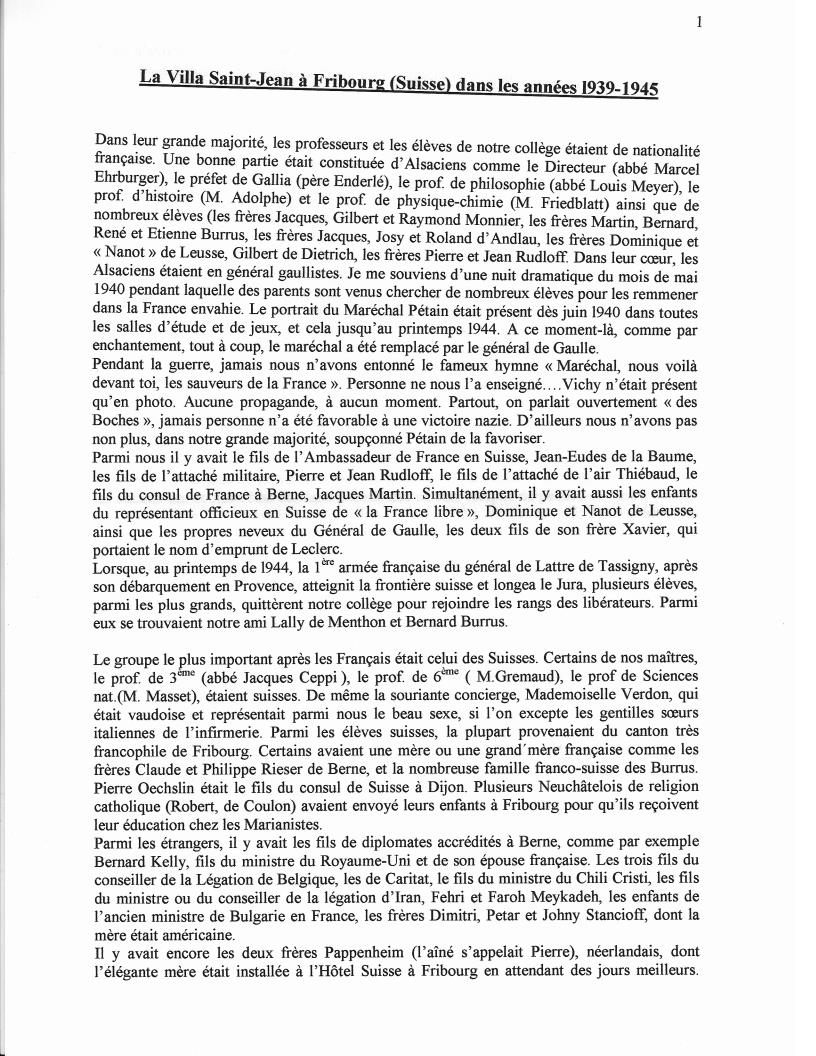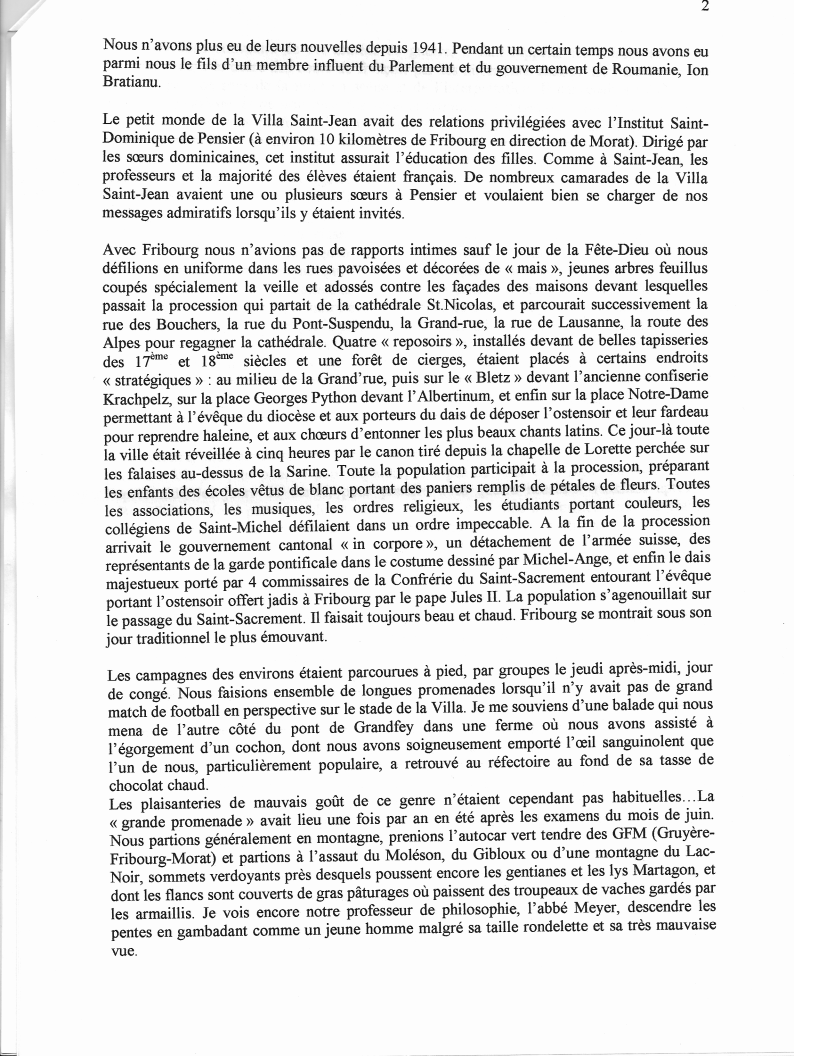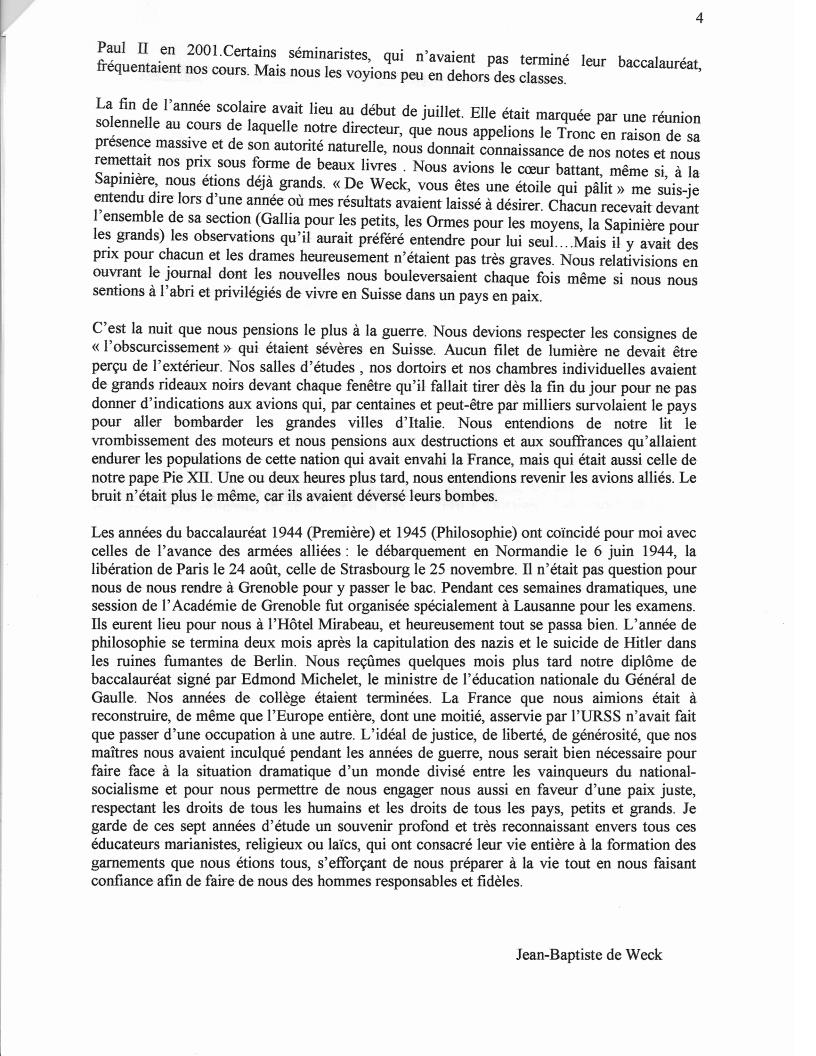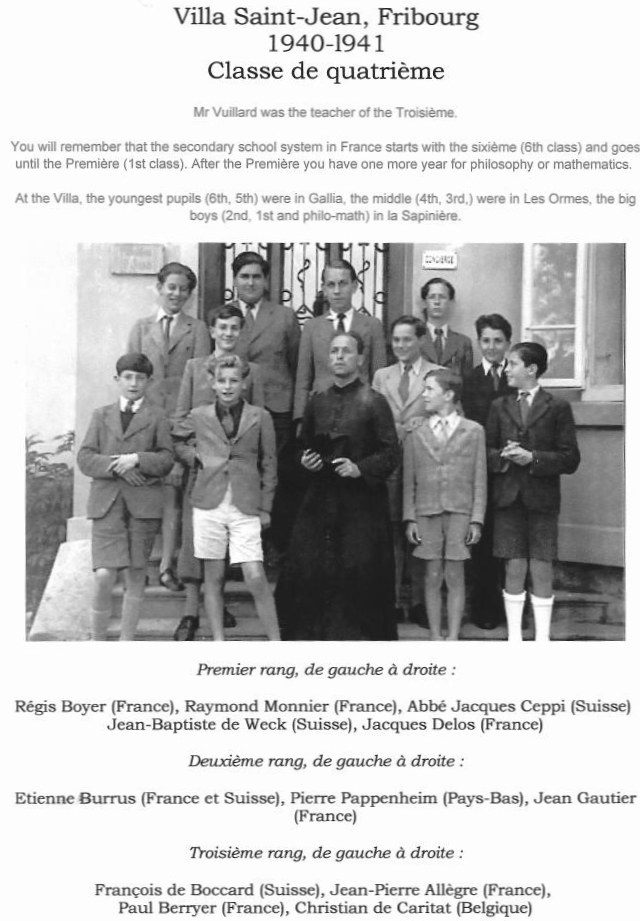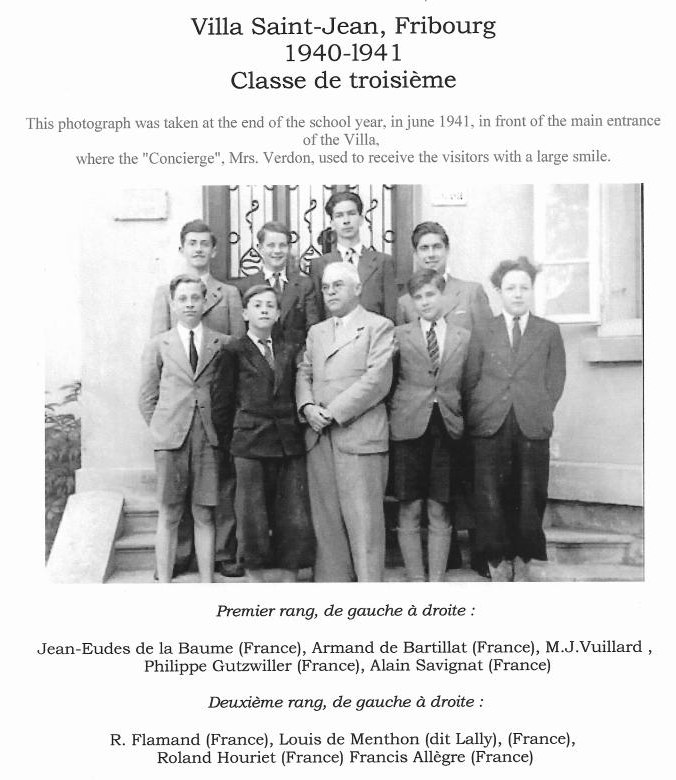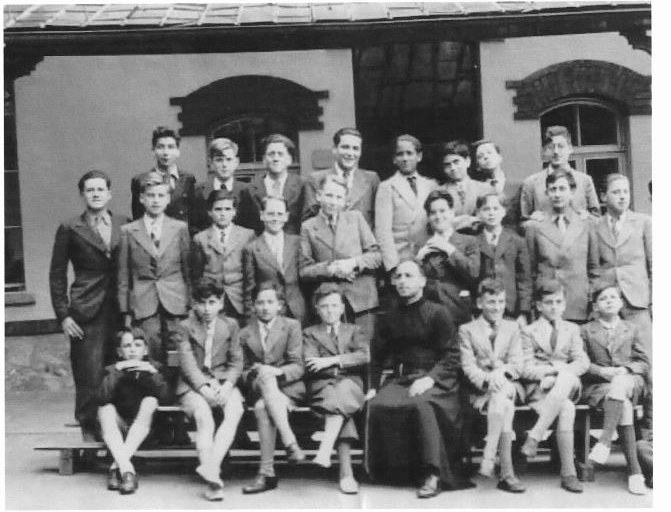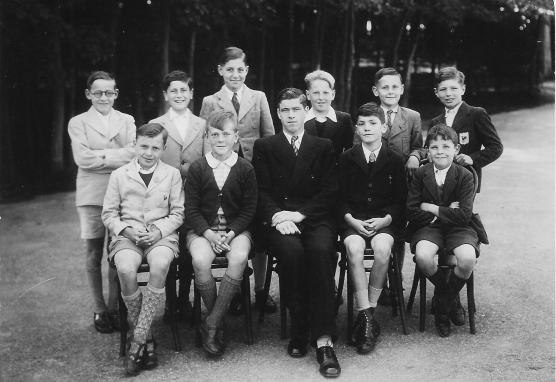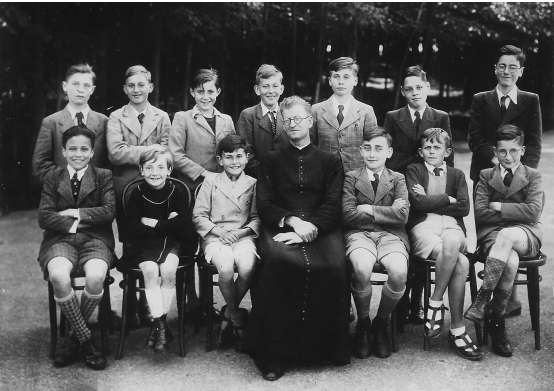 |
Villa St.-Jean Collège Français
Student Remembrances |
 |
Villa St.-Jean Collège Français - Fribourg, Switzerland Student Rembrances & Photos
Editor's NOTES: There were several contributors to this Section who certainly deserve acknowledgement.
1) Most of the Photo alblums are from a CD carefully compiled from a number of contributors by Former Villa student Kevin Di Palma . Kevin's CD was kindly sent to me by
François "Chris" Orenga de Gaffory. So thank you Kevin and thank you François.
I've separately had François Ronsin identify some of the personnel in the photos - credit is stated under the appropriate photos.
2) Former Villa student Guy Allegre was kind enough to send my some digital images that were important to him and that he remembers from his time (1940s) at Villa St.-Jean Collège Français.
It seems that some of the images were from an earlier web site that François Ronsin was involved in (translating the English Wikepedia Page),
with some of the text written by Jean-Baptiste de Weck. So thanks also goes out to both François and Jean-Baptiste.
3) Also, former Villa student Gérard Orsel has provided me with new and updated higher resolution scans of photos and text originally sent to Kevin concerning his brother Guy Orsel who attended the Villa
in the period 1917- 1920
LOCAL PAGE MENU - Click on Hyperlink to Jump to Desired Section
1910-1914: Remembrances of Sebastieo Bastos
1917-1920: L'album de photos de Guy Orsel
1921-1923: L'album de photos de Christian Orsel
1933-1934: Comment from French author Jean-Christophe Notin
1935-1938: L'album de photos de Jean Halbeisen
1936-1940: L'album de photos de L'album de photos Marc Freyburger
1939-1945: L'album de photos de Jean-Baptiste de Weck
1940-1945: L'album de photos de Guy Allegre
1948 - 1956: L'album de photos de François Ronsin
1951-1953: L'album de photos de Gerard d'Orval
1952-1954: L'album de photos de Arthur de la Grandière
1953-1954: L'album de photos de Francois de Buzon
1952-1957 L'album de photos de Francois Ullmann
1954-1958 L'album de photos de Roland Bonnefous
1954-1960: L'album de photos de Gerard Orsel
1957-1961 L'album de photos de Francois de Reinach
1961-1962: L'album de photos de Vincent Farage
Villa St-Jean 1910-1914: Remembrances of Sebastieo Bastos
Sebastieo Bastos
An Amazon Indian recounts the remarkable story of
his life
(including his days at Villa St. Jean).
"Ma forêt au bord du grand fleuve"; par Sebastião Bastos ; récit recueilli par Claude Mossé.
Published 1976 by R. Laffont in Paris.
This is the
story of Sebastieo Bastos, and it is a lot more then a mere biography. This extract from the book of the same name is as
well the history of the systematic exploitation to which Brazilian Indians have been
subjected to since the rubber boom of the late 19th Century. The personal endeavor of the
chronist is tightly linked to the destruction of a people for which the forest on the
banks of the big river are the reference point for all decisions in life; this is where
Bastos learns to distinguish between "the significant and the insignificant".
His account is the novel of a man locking for a time gone by.
Bastos is the son of a Mahari Indian and a mestizo father who in the years before the
first world war was the owner of a rubber plantation, which allowed him to amass a small
fortune. This is how he could afford to send his son Sebastieo to a boarding school in
Fribourg, Switzerland, where the little Indian studied with the likes of Antoine de Saite
Exuperie and the Agha Khan.
With the outbreak of the first world war his higher education is terminated. He returns to
Brazil as a fifteen year old boy to hear that his family now is completely broke. Father
Bastos was betrayed by one of his business partners. When Sebastieo realizes what
injustice has been done to his father and family, he solemnly swears never to wear a hat
again, until he has taken complete revenge for all the shame and disgrace.
Besides the adventurous human fate of this man, we learn a lot about the customs and
habits of the Indian tribes of the Amazon basin, but also about the ritual of Macumba, in
which Christian and African traditions are melted into one. Bastos tells us about the life
in the jungle, the danger of snakes big and small, about hunting crocodiles, the
bloodthirsty Piranhes and defending themselves against the not much less murderous
adventurers and exploiters from all over the world, who come looking for profit in this
"Green Hell".
Back in 1976 when this book was published, Sebastieo Bastos was living near Manaus, the
proud father and grandfather of many children from several wives. At the time he was
witnessing with the Indians own sad resignation, how his beloved native lands, the world
of the jungle, was being destroyed by the bulldozers of a society looking for profit.
For the 500th anniversary of the discovery of Brazil by the Portuguese Pedro Alvares
Cabral, for the 100th anniversary of Sebastieo Bastos, for the 2000th anniversary of
Jesus Christ, and for the 20th anniversary of my Texas boots next year, I would love to
translate this book into English and Portuguese and visit the places he talks about, and
report with pictures and text live on the internet about the changes that have occurred.
It might be a very welcome story in these days of global economic turmoil, where some of
us are asking ourselves again about the virtues of the Protestant work ethic and the ever
increasing wealth of the first world and the unrelenting poverty endured by the third
world.
Bastos was born on the 19th of January 1900 on the upper regions of the Rio Madeira. He
was raised in the ways of the Indians by his lifelong friend and guide Joachim, who was
working on the plantation for his father and taught him all that was necessary to survive
in the jungle. As a child he went through a bout with malaria, which prompted his father
make a vow, that if young Sebastieo would survive, they would not cut his hair until he
was 7 years old, when his father would take him to town and have him christened and then
take him to a boarding school at a convent near the capital of Belem. This is where he
mostly learned mathematics and the meaning of racism.
In August 1910 his father took him on a journey across the Atlantic Ocean to Cherbourg,
France. Ten days in Paris and the Eiffel tower and all, and then to the College St. Jean in
Fribourg, Switzerland. That was the last time he saw his father.
More racism at that school, with the only joyful experiences of good soccer games and his
first kiss in the spring of 1913 from a girl of rich family in Luzern. This of course
caused a scandal, for which he then had his winter 1913 /14 holidays and Sundays to spend
with an elderly Swiss German couple who were retired high school teachers. They were
convinced that a good dose of Protestant ethics will get this little Indian after all to
become a proper Brazilian. In that winter of 1913/14 he does though notice that the
atmosphere at the school is changing rapidly and by February some of his class mates are
packing their things and leave the school in a hurry.
After the exams in the spring of 1914, the couple tells him of their plan to take him on a
visit to Vienna, to show him what grandeur can be achieved through order and discipline.
In history class he learned to what excesses such ambitions can drive a man, thinking of
Napoleon, who fought all the way to complete destruction at Beresina and Waterloo.
Even though the couple believed firmly that there was going to be a war, they were not
about to get discouraged with their plan to show him Vienna, since they believed firmly,
that the forces of the Emperor will show the French in no time where they belong.
On the day the first shots were fired in Sarajevo, the couple got into a terrible rage,
screaming in Swiss German and yelling at the French Swiss frier, when they brought young
Sebasti�o back to the school.
"This time we'll not get around a war", they
said.
"This despicable assassination was certainly the doing of the Jews and the
Freemasons. France is full of such riffraff."
"War is certainly a very disturbing thing. Let's pray to God, so that maybe a miracle
may still occur", responded the director of the school.
"What's going to happen to the students?"
"Our teachers all have followed their calling to fight on the side of the French
army, German teachers we do not employ. Most of the students have left for their homes,
let's hope somebody will soon come to pick the little Indian."
"We in any case can not keep him any longer with us. And if there is any fighting
going to have to be done, I hope you agree with us, that it is in our national interest to
align ourselves with the Emperor, wouldn't you agree, Father?"
"Not exactly", responded the frier, "I am Swiss, I'm a man of the cloth,
and I am the director of a school, where children from all countries in the world can live
and learn together in peace. I hope that our country will remain neutral. Nevertheless,
even as a devout Catholic, I taught my students, that the German Poet Heinrich Heine had
to leave his fatherland because he was a Jew...It is a question of propriety..."
The couple left in a rage, and that was the first time the director of the school hugged
the little Indian and said,
"Sebastieo, it has not always been easy for you to fit
into the order of our school, but soon you will be back home in your forest, where animals
only kill for food. Here on this side of the ocean, humans are usually worse than animals.
Some of your classmates will soon shoot at each other, even though they were friends for
years. When we colonized your part of the earth, we wanted to have you believe us, that we
would bring you peace and culture. We came in the name of Jesus Christ, and under the
protection of the cross, we enslaved your ancestors, stole their belongings and brought
back your gold. If it comes to all out war, let's hope and pray to God, that it will be
the last. Don't forget us when you are back in your forest and pray for us. Freedom is the
most precious thing there is, and peace is what this earth desperately needs!"
Three days later Bastos is on his way back to Brazil, and eventually starts his journey
through the Amazon, looking for his father to get back the property that was taken away
from his family.
In 1915 he goes back to the Jesuit boarding school in Belem, to see if they have any
leads of the whereabouts of his father. The journey then takes him to Altamira where he
finds one of his fathers former employees. There he learns, that his father died three
months earlier in the house of his aunt just outside of town. This is also the moment when
he realizes, that the Brazilian rubber boom is definitely over. Thanks to the British, who
managed to smuggle enough rubber tree seeds out of Manaus to start their own plantations
in southeast Asia, the price for latex had completely collapsed from its all time high in
1912. In this town he is also introduced to Macumba and a German Jew by the name
Frankenheim. He is not so sure what to make of that fellow, since he knows, that it is the
Germans who are at this time killing his former French school teachers, and supposedly the
Jews who killed the founder of Sebastieo's Catholic faith. He does however decide to
trust him, when the foreigner offers to help him fight his father's former partner in
court back in Manaus. Sebastieo is of coarse in great danger to get killed by the
accomplices of that guy, and in some strange twist of fate ends up getting drafted into
the millitary to serve as a jungle guide in the border war between Peru and Brazil on the
upper reaches of the Rio Solimees. His service starts on the day after his 16th birthday,
and the story continues with trips by canoe and white water rafts.
In late November 1917 Frankenheim hears of the Bolshevik Revolution and then explains to
Sebasti�o in great excitement that a great thinker by the name of Lenin got rid of the
Czar in St. Petersburg, and that soon there will be peace on earth and freedom for all,
and that this will eventually bring the people of the forest what they need to combat the
evils of capitalism. Sebastieo and his Indian mother do not exactly understand the
significance of those events that are happening in the freezing cold of a country 10,000
miles away, and so don't pay much attention to it.
But when the Americans get into the war on the side of the French Alliance, he get's
really worried, thinking that the US might do with Europe what the capitalists were doing
with his people in the forest.
In the winter of 1918 he and his old friend Joachim make their way back up the Rio Madeira
to the plantation on the Jamare in hopes they would find some traces of his father's
former partner. After all, there was also supposedly diamonds in that region. But no one
is to be found and so Sebastieo leaves Joachim behind to restore the abandoned house and
continues on the elusive search of the villain. In the years following, he wanders around
the region of northern Rondonia, recalling also the expedition by General Rondon and
Theodore Roosevelt in 1914 down the river of doubt, which then was renamed in Roosevelt's
honor.
In 1923 he comes down with a bout with malaria and ends up in a little Indian village on
the Rio Taripare. The chef musters him out and after he has proven to be a good guy,
hunting with the men and paying respect to the ancestors of the tribe, he is rewarded with
a bride. Bastos enjoys this new situation for a while, but eventually convinces the chef
that he must continue on his solemn journey. He finds his way back to Joachim on the
plantation in 1924, where he finally gets to meet the foe.
Over the next few years he travels back and forth to court in nearby Humaite and visits
at his mother in Manaus. 1929 brings finally some calm into his soul, as the death of the
villain of the story now terminates any legal chances to get the title to their property
back. In the years following, he and Joachim continue living in the forest, reporting in
word and writing to the Governor about the small and disappearing Indian villages of the
Amazon.
On a visit to his mother in 1943 he gets to hear about the renewed troubles in Europe and
gets to meet his second wife. In 1944 he loses his mother and in 1957 after 13 children
his beloved wife. This prompts him to move back to the city and for the first time in his
life makes a modern living as the secretary of the market of Manaus. Following the opening
of the first travel agency and regular commercial air traffic in 1965, he becomes a
somewhat reclusive tour guide, sadly observing the destruction of his native forest on the
banks of the big river.
Click on link to RETURN To TOP Of Page & Local MENU
Villa St-Jean 1917-1920: L'album de photos de Guy Orsel
VILLA SAINT-JEAN Collège Français
Fribourg, Suisse
L'album de photos 1917 a 1920
Guy Orsel

Guy Orsel
Né le 25 juin 1902
Décédé le 25 décembre 1981

|
Guy Orsel
(1902-1981) est reste 3 ans a la Villa St Jean, de 1917 a 1920.
Ses parents habitaient pendant la guerre 14/18 pres du front, et avaient souhaite qu'il ait de bonnes conditions pour ses etudes, ainsi que son frere Christian.
Guy Orsel a dirige plus tard des entreprises le Lait Mont Blanc, a Rumilly (Haute-Savoie), et ses 3 fils, Jacques, Gerard et Eric ont tous trois ete a la Villa Saint Jean.
Il avait tellement apprecie Fribourg qu'il a apouse en 1941 une Fribourgeoise, Simone de Boccard (dont le frere Francois avait ete a St Jean 20 ans apres lui). Apres le deces de
Simone en 1966, il se remaria en 1969 avec une autre fribourgeoise, Colette de Weck .
Parmi ses souvenirs marquant de la Villa, il a assiste en direct, lors d'une promenade, a la chute du pont suspendu du Gotteron ! Guy Orsel a bien connu Antoine de St Exupery, qui etait 2 classes avant lui.
Son album de photos 1917 a 1920 (malheureusement tres defraichi) dormait depuis longtemps au fond d'une malle, mais, grace a Kevin Di Palma, il verra l'eternite
Gerard ORSEL (1954-1960)
Guy Orsel posant pour l'eternite dans sa chambre a la Sapiniere
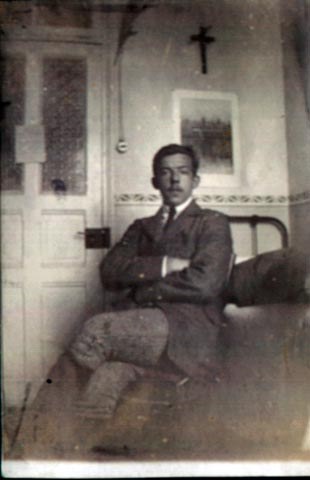
|
|
Guy Orsel dans les bois de Villa St Jean 1919

|
|
Guy Orsel attable avec ses amis de classe, a la terrasse d'une auberge

|
|
|
|
|
Jeune fr�re de Guy, Christian Orsel,
que l�on voit dans le chambre de Guy
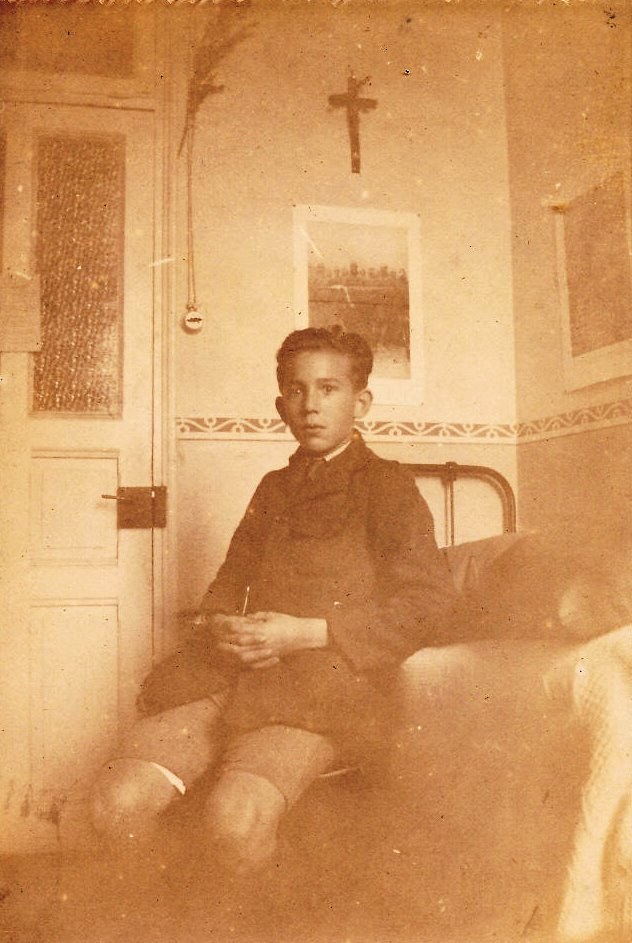
|
|
Villa St Jean 1919 Equipe de Football
Guy avec ballon
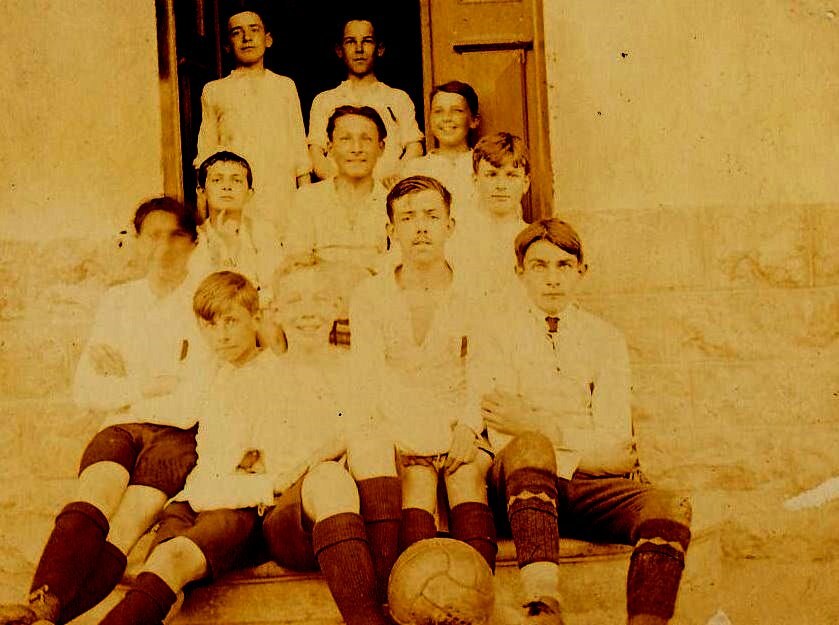
|
|
Villa St Jean Equipe de Football
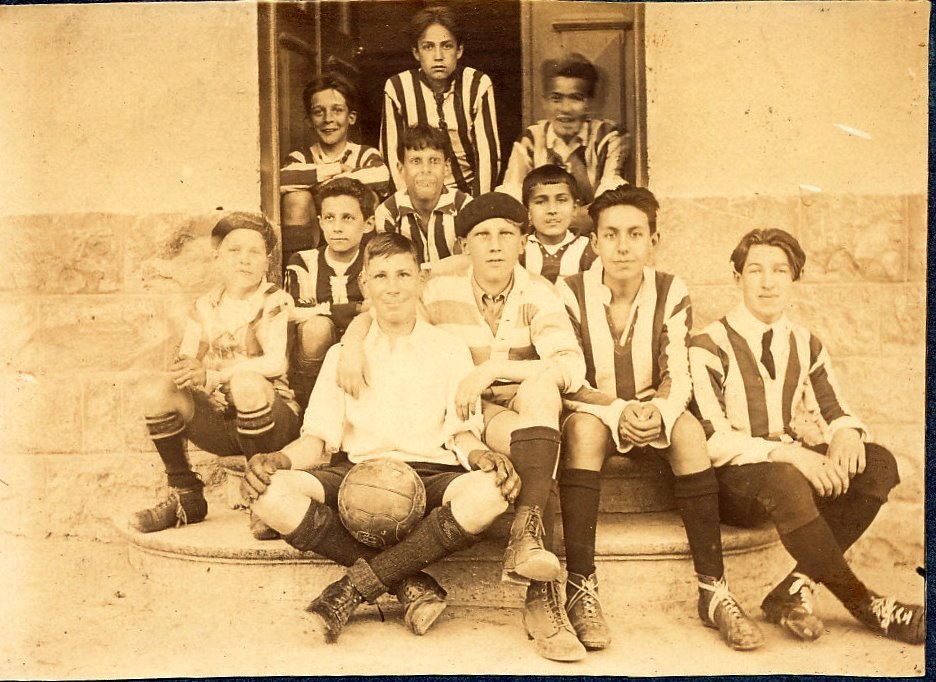
|
|
La photo avec un groupe deeleve doit etre la classe de premiere en 1919/20
(Guy est le 4eme en partant de la gauche)

|
|
La photo avec un groupe deeleve doit etre la classe de premiere en 1919/20
(Guy est le 4eme en partant de la gauche)

|
|

|
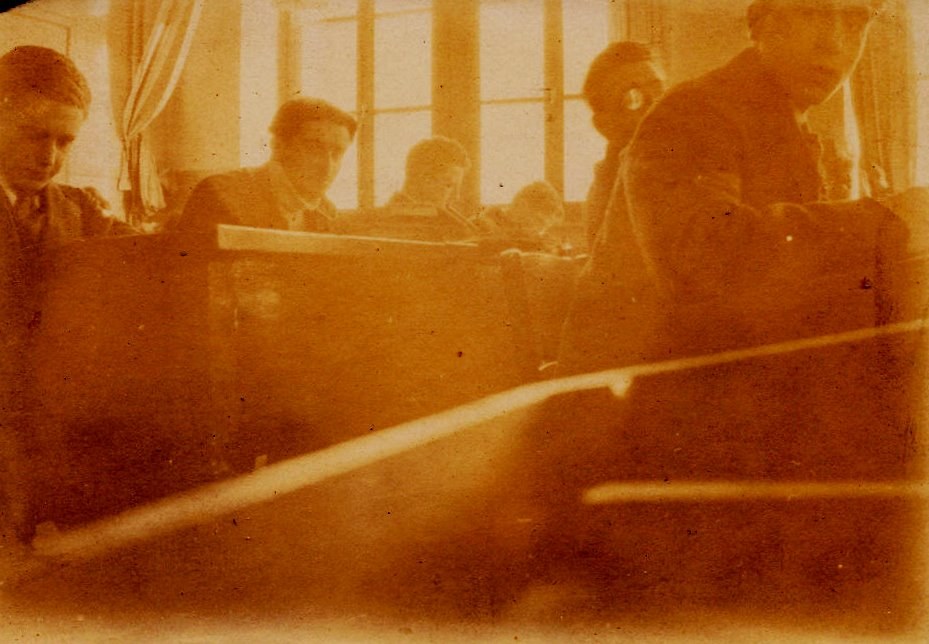
|
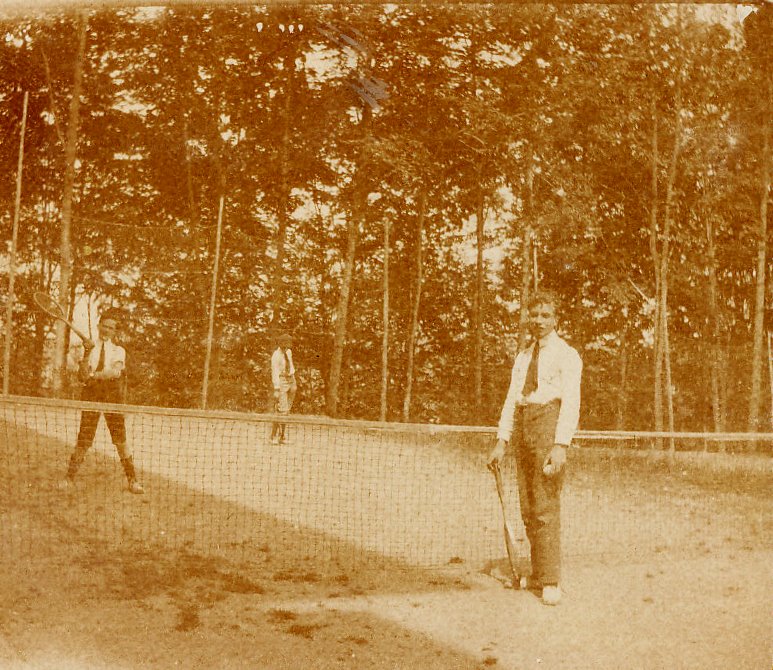
|
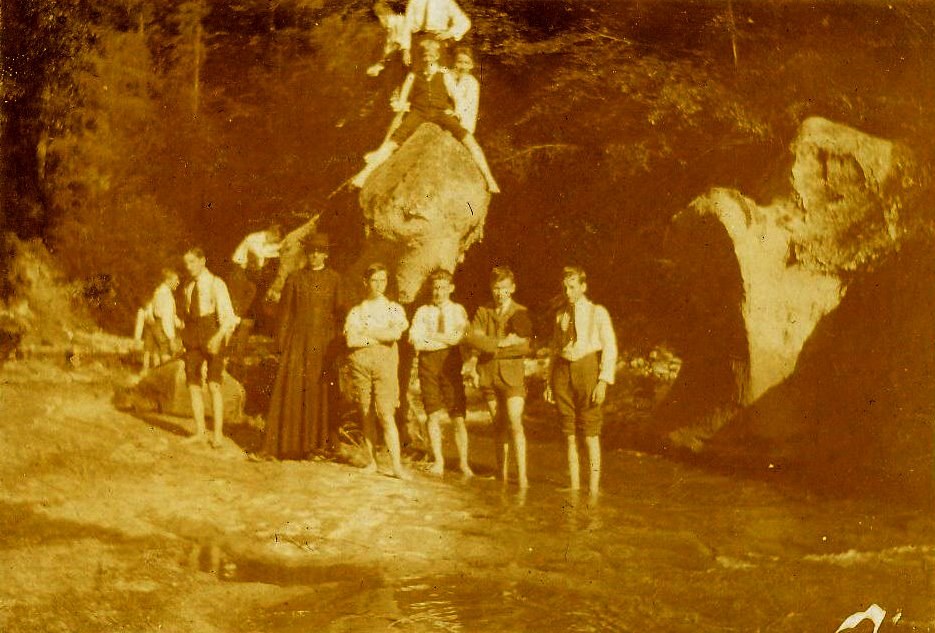
|
Lac Noir
(Est un lac naturel d'environ 0.5 km2 situé dans le canton suisse de Fribourg dans les Préalpes fribourgeoises )

|
|
Villa St Jean Students at Lac Noir in 1919
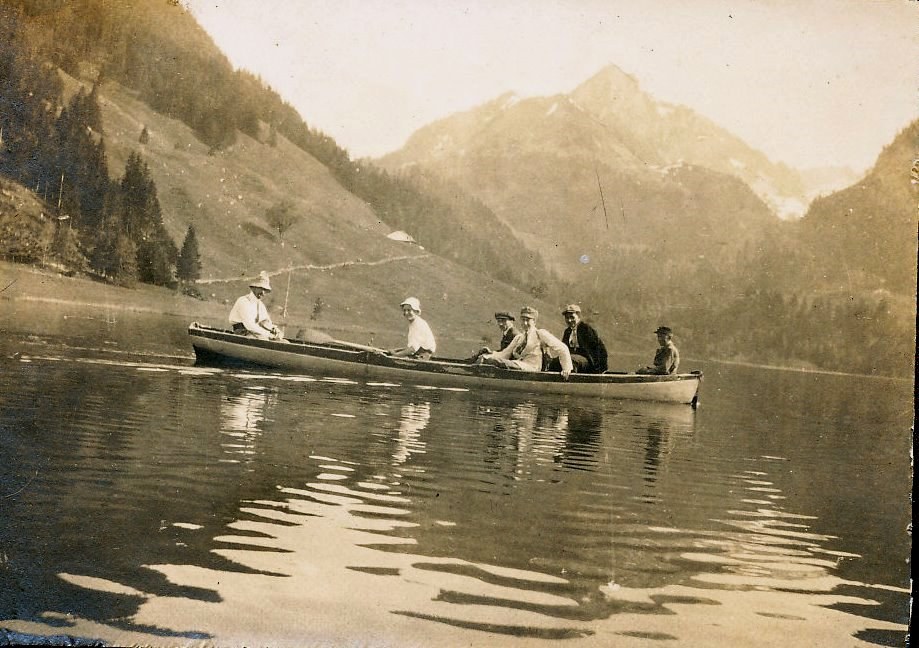
|
|
Lac Noir

|
|
|
Le drapeau porte par un groupe deeleves pour la fete Dieu porte le nom de Gallia

|
|

|
|
|
|
Guy Orsel est tout a gauche (soldat romain ?)

|
|
Villa St. Jean La Sapiniere 1919

|
|
|
|
La Sapiniere
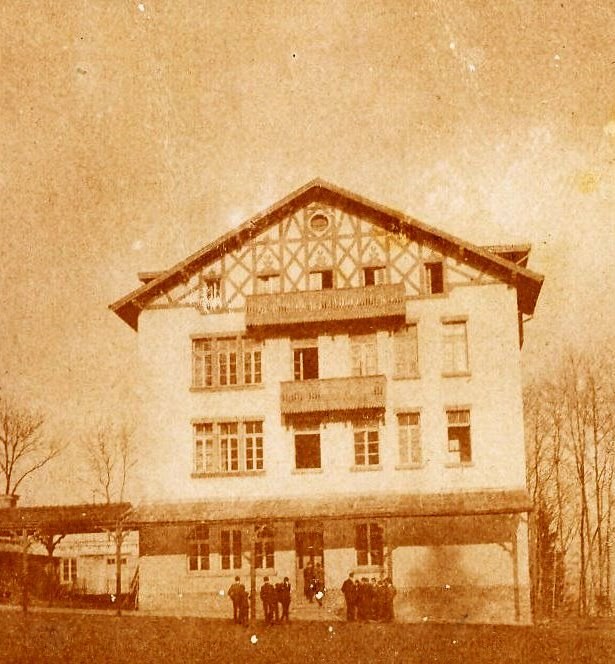
|
|
Chambre de Guy Orsel a la Sapiniere

|
|
|
Villa St. Jean From Sports Field 1919
Note Brothers Walking The Track on the Left

|
|
Villa St. Jean Student Bicycle Outing 1919
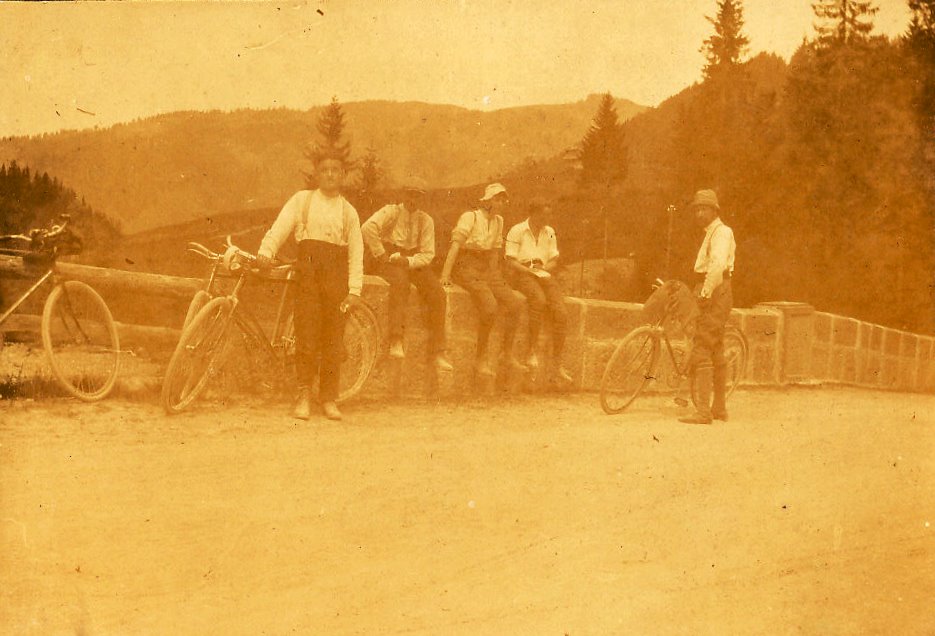
|
|
Villa St. Jean Student Skiing Outing 1919
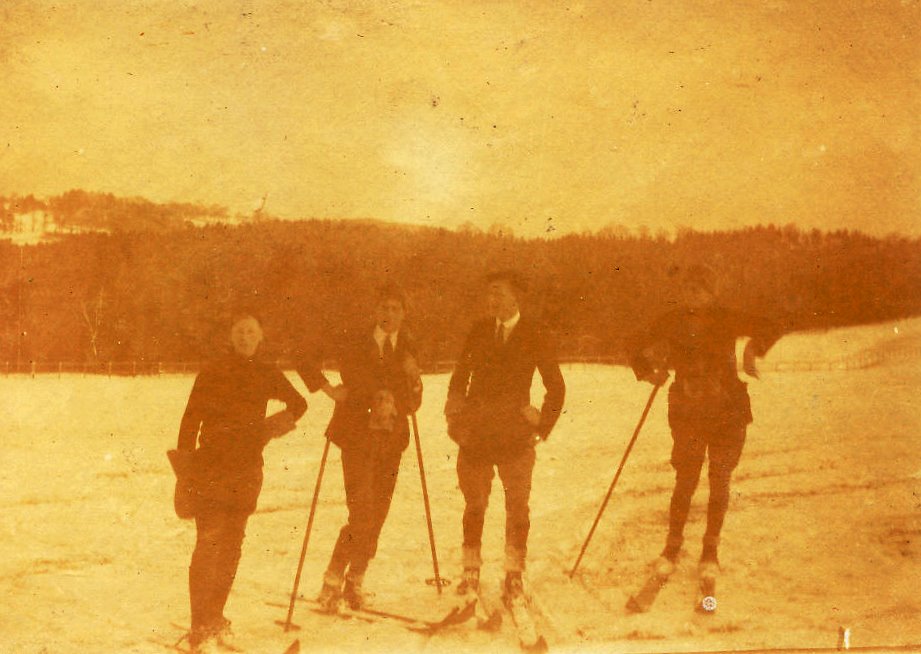
|
|
Villa St. Jean Student Skiing Outing 1919

|
|
|
|
IceSkating at Villa St. Jean in 1919

|
|
Hockey at Villa St. Jean in 1919

|
|
|
Hockey at Villa St. Jean in 1919

|
|
Football at Villa St. Jean in 1919

|
|
Mountain Climbing at Villa St. Jean in 1919

|
|
Bob Sleighing at Villa St. Jean in 1919

|
|
|
|
Afternoon Bicycling at Villa St. Jean in 1919

|
|
Villa St Jean 1919 Directeur

|
|
Villa St Jean Students at the Sarine River in 1919
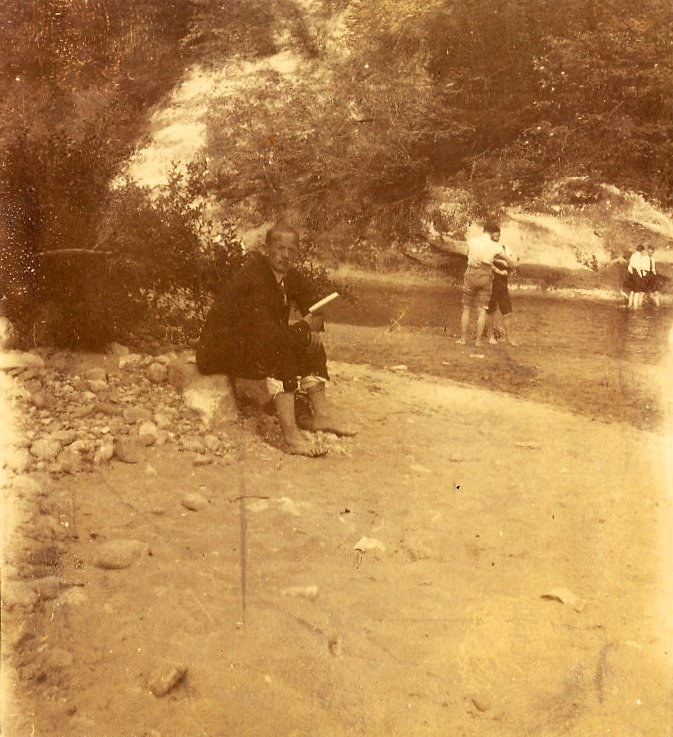
|
|
Sleighing at Villa St Jean Natation 1919

|
|

|
Villa St Jean Natation au Lac Noir 1919

|
|
Fete Dieu Fribourg, Suisse 1919
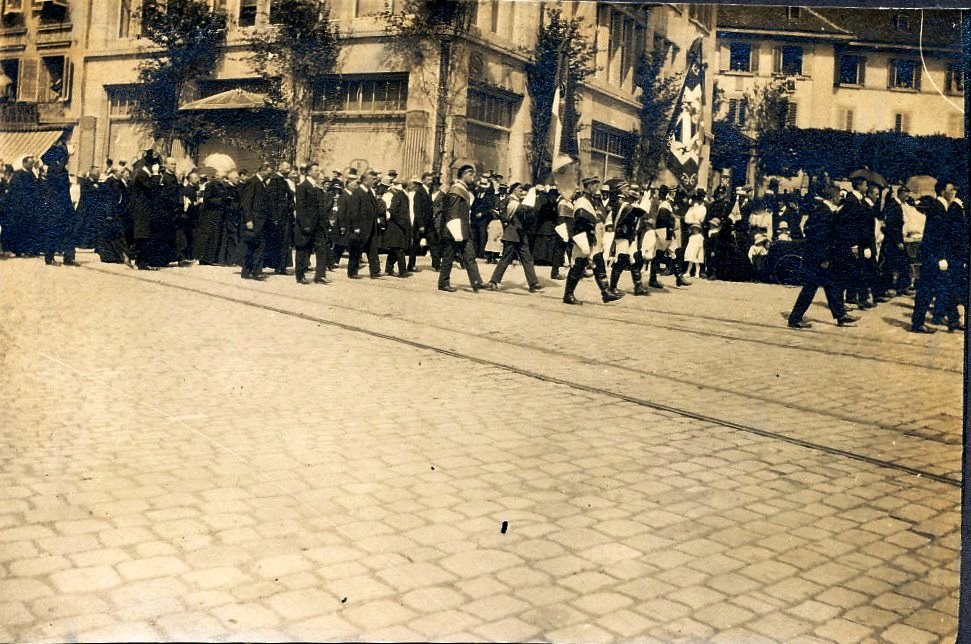
|
|
Villa St Jean vue Pont Gotteron 1919
(Et le pont suspendu avant queil ne seecroule voir: http://www.notrehistoire.ch/article/view/1006/ )
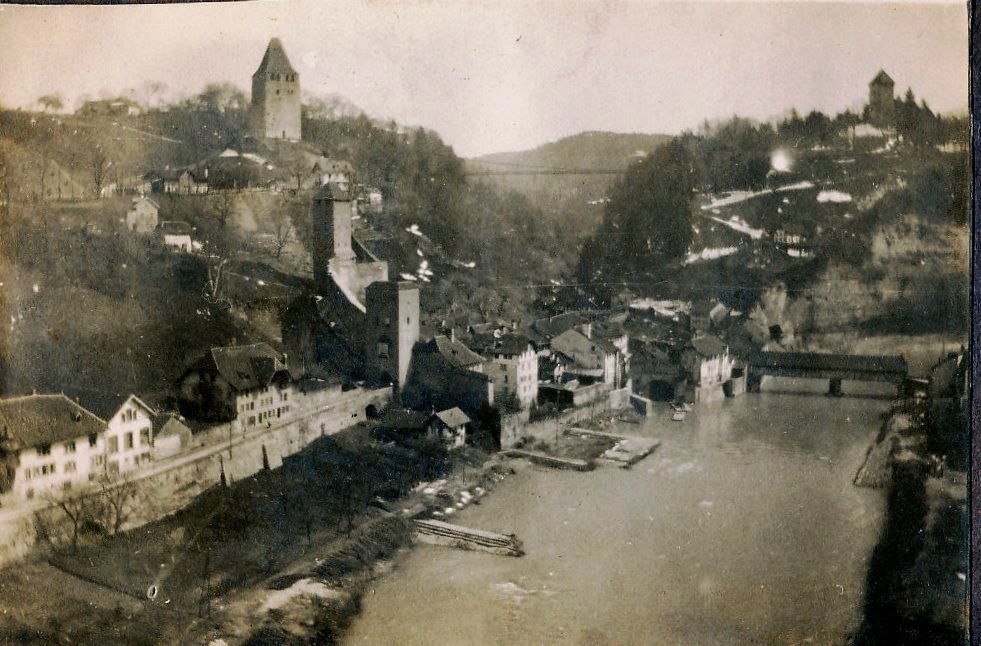
|
|
|
Click on link to RETURN To TOP Of Page & Local MENU
Villa St-Jean 1921-1923: L'album de photos de Christian Orsel
1921 Quelques matchs de championnat sont joues avant l'hiver " le Stade en gagne deux contre << Saint-Pierre >> et <>.
Mais il termine la saison par une defaite serieuse contre << Olympic >>. Signalons aussi quelques rencontres amicales, jouees pendant un automne qui se maintient tres longtemps au beau.
L'hiver arrete les jeux de football; nos equipiers, sportifs dans l'eme, le remplacent par la luge, le ski ou le patin ; sur la Sarine, ils organisent meme du hockey sur glace.
(x Christian Orsel)

|
|
1921 Fete sportive (19 juin). -- Depuis longtemps, a la Villa, la culture physique est en honneur: foot-ball, tennis, gymnastique ne manquent pas d'amateurs.
Aussi une fete sportive s'est-elle introduite dans nos habitudes: course de vitess en bicyclette, course de lenteur, course a pied, saut en longueur et en hauteur, lancement de grenade, etc.,
n'ont plus de secret pour nos sportsmen.
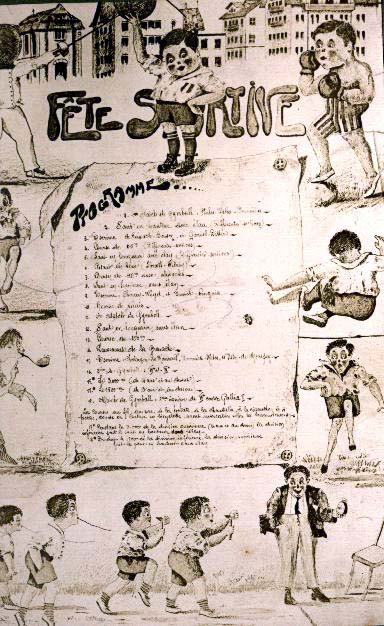
|
|
1921 TABLE DES MENTIONS Classe de troisieme
Ludovic de Bremond, Thephile Burger, Jean Causse, Gaston Crovisier, Roger Delingette, Gaston Ditter, Angel Jotzoff, Antoine Lefebvre, Christian Orsel, Antoine Tulbendjian, Ladislas Vasquez, Jean Vielle
One quitte pendant l'annee: Auguste Bellicam, Ernest Bellicam, Andre Dembinski

|
|
1921 Le Velo-Club
La premiere fut faite le 11 novembre, anniversaire de l'Armistice de 1918. Vraiment, nous eemes ce jour-la de l'audace. Bien nous en prit d'allieurs car elle nous valut la fortune.
Berne etait notre but; le depart eut lieu de bonne heure, car c'etait jour de fete a la Villa St-Jean.
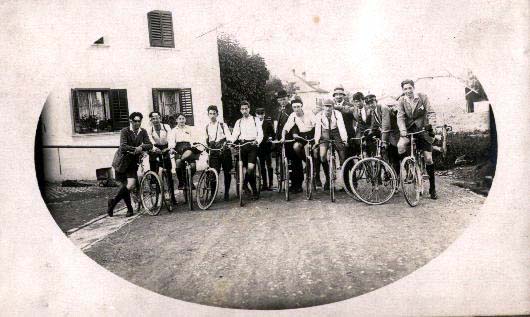
|
|
1922 Le Velo-Club au Lac Noir
Fribourg est notre cage, mais c'est une cage bien doree, car le pays qui l'entoure est digne d'etre aime

|
|
1922 Il n'en restera pas moins pour nous des resultats dont nous serons heureux; avec le developpement physique acquis,
nous garderons le souvenir tres agreable de ces annees de notre adolescence passees a la Villa St-Jean dans les conditions les plus favorables pour d'education complete de notre corps et de notre eme.

|
|
1922 Les chaussures de foot sont tirees des coins obscurs ou elles ont pris, pendant les vacances, un repos bien merite,
et notre terrain ou l'herbe a repousse, se peuple de joueurs. C'est une veritable francsie, pour commencer ; et puis, le calme se faisant peu a peu, l'on se dispose a elire avec beaucoup de serieux un Comite,
comme tout club qui se respecte.
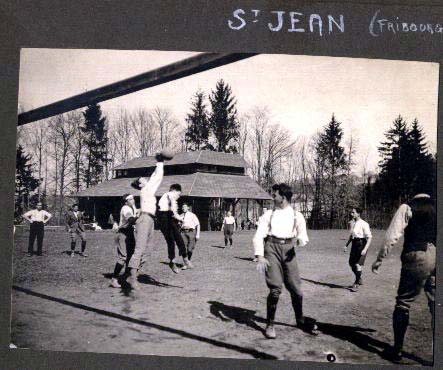
|
|
1922 A peine rentres a la Villa, les habitues du ballon rond sentent renaetre en eux, avec l'ardeur des etudes, bien entendu, la passion du football.

|
|
1922 Depuis trois ans deja, la France panse ses cruelles blessures " << La guerre est finie, disent les mamans, nous pourrons garder nos enfants.>>
Mais ne reste-t-il pas la guerre economique a mener contre les ennemis du dehors ? Ne faut-il pas defendre les interets du pays et mettre toutes les energies en oeuvre ? Les eleves de la << Sapiniere >>
ont bien compris la tache patriotique qui leur incombe.
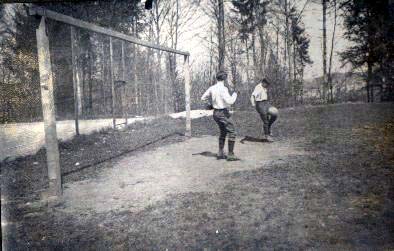
|
|
1923 Le Stade conviait tous les sportsmen de la Villa St-Jean, a venir esssayer leur force dans des matchs a six et mettait en competition de superbes
coupes d'une belle valeur artistique.

|
|
Depuis trois ans deja, la France panse ses cruelles blessures " << La guerre est finie, disent les mamans, nous pourrons garder nos enfants.>>
Mais ne reste-t-il pas la guerre economique a mener contre les ennemis du dehors ? Ne faut-il pas defendre les interets du pays et mettre toutes les energies en oeuvre ? Les eleves de la << Sapiniere >>
ont bien compris la tache patriotique qui leur incombe.

|
|
1921 Le pont de Perolles
Notre chere ville de Fribourg se transforme et se renouvelle au detriment, helas ! de son aspect de cite medievale. Mais est-ce un tort que de vivre avec son temps? Certes, les ducs de Zaehringen surent,
avec beaucoup d'a-propos, choisir pour leur ville un endroit de defense facile, encaisse entre deux falaises.

|
|
|
Click on link to RETURN To TOP Of Page & Local MENU
Villa St-Jean 1933-1934: Comment from French author Jean-Christophe Notin
As a side note, French author Jean-Christophe Notin has commented to me , that the Director of French intelligence from 1970 to 1981 Alexandre de Marenches attended Villa Saint Jean at least from 1933 to 1934.
In 1970 Alexandre was installed as head of the S.D.E.C.E. (SDECK) the forerunner of the current Direction Generale de la Securite Exterieure (D.G.S.E.). He would remain in this post for 11 years.
Click on link to RETURN To TOP Of Page & Local MENU
Villa St-Jean 1935-1938: L'album de photos Jean Halbeisen
Kevin's original comments: "Mr. Jean Halbeisen sent us these photos for inclusion here. Mr. Halbeisen lives in France and has many fond memories of the Villa.
Jean's daughter, Michele Latimer, lives in Boston. Michele recently visited her father in France and brought back these photos.
We thank them both for the photos! They are a great addition to our web page. "
1935-1936 class de 5eme photo taken outside Bossuet.
Jean, third row center, poses with his classmates several who wore short pants suits, a fashion of the day.
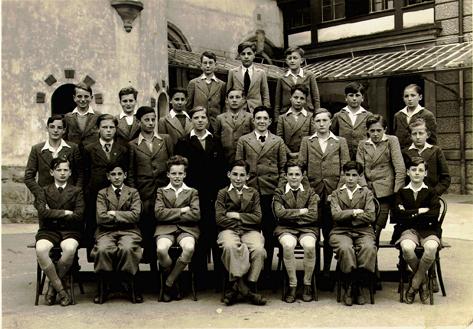
|
|
The students signed the 1935-1936 5eme class photo

|
|
A close-up of Jean Halbeisen

|
|
|
Skating on the Sarine
Jean Halbeisen, looking very dapper in his beret and knickers, tells us this was a "very cold" winter.
The boy on the left is Legrand de Fecamp. Legrand's parents owned Benedictine and Legrand would sometimes bring "samples" back with him upon returning to school.
Unfortunately he has forgotten the name of the boy on the right. ..... but doesn't he look a bit like the "Sheik" !
Jean says that these students would flood the Sapiniere tennis courts at night and skate the next day. Seems that "Sapi Skating" was still popular in 1968.
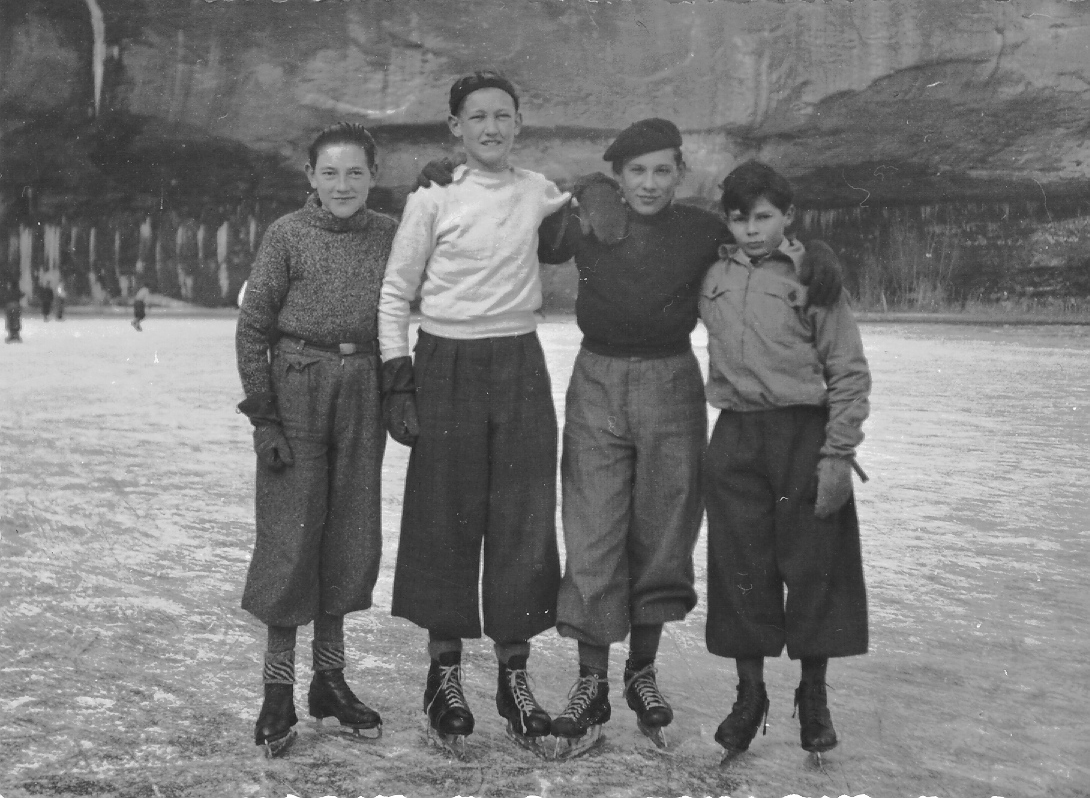
|
|
Mr. Halbeisen recently signed the back of this Skating on the Sarinephoto.
He didn't remember the name of the boy on the right.
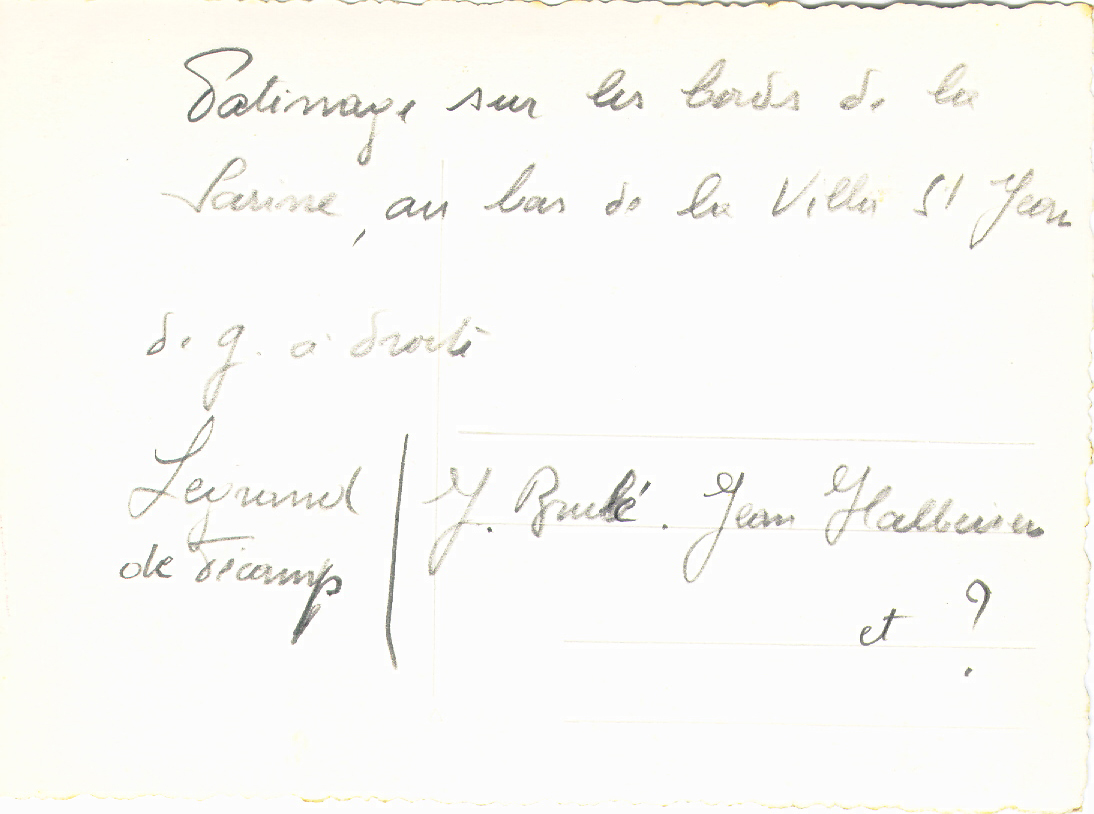
|
|
Under the banner of "Maria Duce" ('Mary Our Leader') one student wears a burnoose in the center back row - aka the "Sheik"

|
|
A close-up of Jean Halbeisen wearing a pin.

|
|
Jean Halbeisen sits near first base on the asphalt field with the goal post, playing field, and the Pavilion behind him.
The Sapi tennis courts are over his right shoulder.

|
|
Closeup of Jean Halbeisen as per above
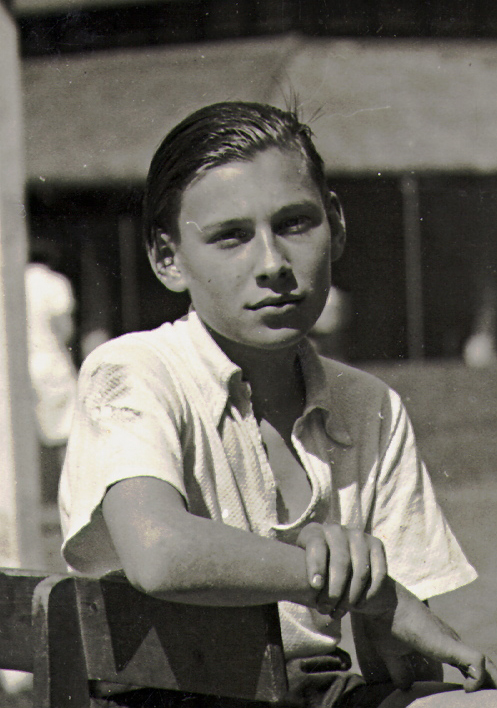
|
|
Two priests, wearing their religious habits, are surrounded by their students.
Jean Halbeisen is in the first row, second from left, wearing his sailor suit.

|
|
Jean, in his shorts, stands next to his older brother, Pierre.
Pierre, three years older, is wearing his long pants suit and holding his camera.
Pierre didn't like the Villa and returned home after one year for home schooling by a tutor.

|
|
Classe de 5ieme a Gallia en 1935
Jean Halbeisen, back row and center, poses with his fellow students.

|
|
Signed class photo

|
|
M. Jean Halbesien returned to the Villa August, 1999.
Jean Halbesien returns to the Villa August, 1999. He had not been back to the Villa in 40 years and was sad to see how unfamiliar it had become.
Only Gallia, the pavilion and the field remain. Even the landscape has changed. He was "appalled" by the new structures on campus. The college was empty for summer.
Jean and his wife managed to talk to a young woman who was living in Gallia. Unfortunately, she didn't even know that Villa St. Jean had existed and couldn't locate anyone who could provide information.

|
|
60 years later Jean Halbeisen returns to the Villa and the location on the sports field where he sat and posed for a picture so many years ago
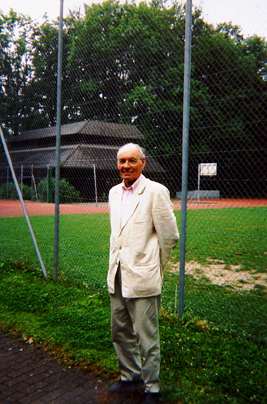
|
|
Jean and his daughter, Michele Latimer pose with the Villa Pavillion in the background.
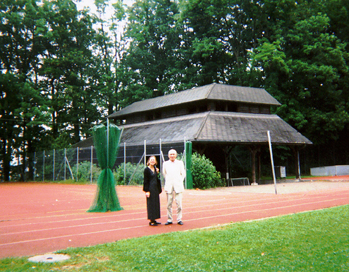
|
|
Click on link to RETURN To TOP Of Page & Local MENU
Villa St-Jean 1936-1940: L'album de photos de L'album de photos Marc Freyburger
a tout hasard voila les noms des garcons sur la photo:
3eme rang de gauche a droite: houriet, feltz, sauvajon, burckle, urruticoechea, quintero, d'andlau, de gonneville
2e: stremler, haefeli, de montenach, moi, burnouf, descamps,de grouchy, chatel, zindel, de mongomery
1er: marrel albert, malye, du sordet, de peyrecave, Abbé Jacques Ceppi, legrand, chomel, hell, marrel gerald

|
|
nos surveillants

|
|
nos surveillants
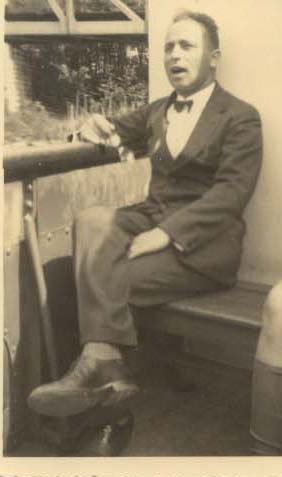
|
|
nos surveillants
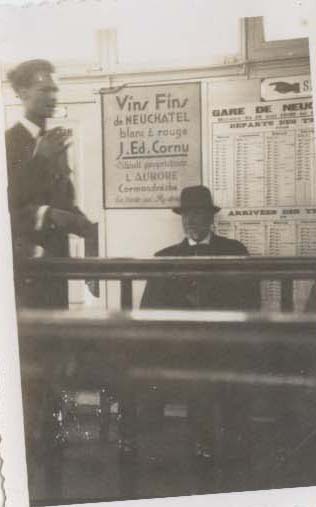
|
|
Saucy 5eme

|
|
Saucy 5eme

|
|
Click on link to RETURN To TOP Of Page & Local MENU
Villa St-Jean 1939-1945: L'album de photos de Jean-Baptiste de Weck
La
Villa Saint-Jean a Fribourg (Suisse)
dans les annees l939-1945
Premiere communion, le 21 mai 1936
Premier rang, de gauche a droite:
Georges de Montenach (Suisse), Jean-Baptiste de Weck (Suisse), Abbe Chazottes,
R.P.Talon, Jacques.d'Andon (France),
P. Garelli (France)
Deuxieme rang, de gauche a droite:
Francois.Balli, Henri de Barrin (France), Jacques d'Andlau (France), Denis Burnouf (France), Claude Maget (France),
Henri Mermillod,
Henri de Cerval (France), Paul Cointe (France)
Troisieme rang, de gauche a droite:
Jean-Pierre Stiegler, Patrice Goury du Roslan (France), Nool Brosset (France), Rene Galland (le plus grand),
Jean Bruley (France), Marcel Schuster, Remy Chavane (France)

|
|
1940-l941 Classe de quatrieme
Premier rang, de gauche a droite:
Regis Boyer (France), Raymond Monnier (France), Abbe Jacques Ceppi (Suisse), Jean-Baptiste de Weck (Suisse),
Jacques Delos (France)
Deuxieme rang, de gauche a droite:
Etienne Burrus (France et Suisse), Pierre Pappenheim (Pays-Bas), Jean Gautier (France)
Troisieme rang, de gauche a droite:
Francois de Boccard (Suisse), Jean-Pierre Allegre (France), Paul Berryer (France), Christian de Caritat (Belgique)
Mr Vuillard was the teacher of the Troisieme.
You will remember that the secondary school system in France starts with the sixieme (6th class) and goes until the Premiere (1st class). After the Premiere you have one more year for philosophy or mathematics.
At the Villa, the youngest pupils (6th, 5th) were in Gallia, the middle (4th, 3rd,) were in Les Ormes, the big boys (2nd, 1st and philo-math) in la Sapiniere.
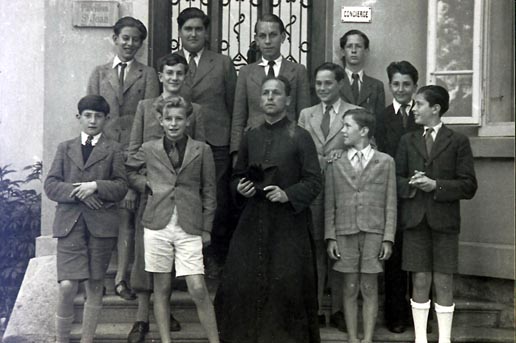
|
|
1940-l941 Classe de troisieme
Premier rang, de gauche a droite:
Jean-Eudes de la Baume (France), Armand de Bartillat (France), M.J.Vuillard, Philippe Gutzwiller (France),
Alain Savignat (France)
Deuxieme rang, de gauche a droite:
R. Flamand (France), Louis de Menthon (dit Lally), (France), Roland Houriet (France), Francis Allegre (France)
This photograph was taken at the end of the school year, in June 1941, in front of the main entrance of the Villa, where the "Concierge", Mrs. Verdon, used to receive the visitors with a large smile.

|
|
1941-l942 Classe de quatrieme
Premier rang, de gauche a droite:
R. Boucher (France), Louis-Andre de Pfyffer (Suisse), Alain Boyer (France), Abbe Tisser, and J. Godefroy (France),
Claude Rieser (Suisse), Dominique de Leusse (France)
Deuxieme rang, de gauche a droite:
Sentenac (dit Oin-Oin), Ehret (France), Rene Geiger, Jean-Loup de Menthon (France), Savouray (France),
J.-L. Paulve (France), Barraud, Robert (Suisse), P. Lodoyer (France)
Troisieme rang, de gauche a droite:
Jean Murat (France), Bertolus (France), Yves Cara (France), de Coulon (Suisse)

|
|
1941-l942 Classe de troisieme
Premier rang, de gauche a droite:
Un seminariste (Aloys Baumgartner ?), Regis Boyer (France), Jean Merens (France), Abbe Jacques Ceppi (Suisse),
Jean-Baptiste de Weck (Suisse), Raymond Monnier (France), Jean Gautier (France)
Deuxieme rang, de gauche a droite:
Un seminariste (P. Dillier ?), A. Grobety (Suisse), A. Balmer (Suisse), J. Ricard (France), Christian de Caritat (Belgique),
R. Dolbeau (France), Jean-Pierre Allegre (France), Paul Berryer (France), Francois de Boccard (Suisse), Faroh Meykadeh (Iran),
Etienne Burrus (France et Suisse)

|
|
This is my article which resumes so many years spent at "la Villa" during world war II. We were really a little community of people living together. I strongly shared the life of the college
as a community. It was the capacity of our teachers to stimulate our social gifts, to awake our generosity and our understanding towards the others. I hope that the Marianists would accept this article as a kind of true recognition of
their great dedication to their young companions. We were educated as equals, as responsible people, and in our large majority we respected them.
Dans leur grande majorite, les enseignants et les etudiants de notre college etaientde nationalite francaise. Une grande partie etait composee d'Alsaciens tels que le Directeur (Pere Marcel Ehrburger), le prefet de Gallia (Pere Enderle), le professeur de philosophie (Pere Louis Meyer),le professeur d'histoire (M.Adolphe) et leprofesseur de physique-chimie (M.Friedblatt) ainsi que de nombreux eleves (freres Jacques, Gilbert et Raymond Monnier, freres Martin, Bernard, Rene etEtienne Burrus, les freres Jacques, Josy et Roland d'Andlau, les freres Dominique et "Nanot" de Leusse, Gilbert de Dietrich, les freres Pierre etJean Rudloff.
Dans leur coeur, les Alsaciens etaient generalement gaullistes.Je me souviens d'une nuit dramatique de mai 1940 au cours de laquelle des parents sont venus chercher de nombreux eleves pour les ramener dans la France envahie. Le portrait du marechal Petain est present des juin 1940 dans toutes les salles d'etudes et de jeux, et ce jusqu'au printemps 1944. A ce moment, comme par magie,du coup, le Marechal est remplace par le General de Gaulle.
Pendant la guerre, on n'a jamais chante le fameux hymne Marechal, nous voici devant vous, les sauveurs de la France . Personne ne nous l'a appris.Vichy n'etait present que sur les photos. Pas de propagande, non moment. Partout on parle ouvertement des Boches, personne n'est jamais favorable a une victoire nazie. D'ailleurs, la grande majorite d'entre nous ne soupconnait pas non plus Petain de le favoriser.
Parmi nous il y avait le fils de l'ambassadeur de France en Suisse, Jean-Eudes de la Baume, les fils de l'attache militaire, Pierre et Jean Rudloff, le fils dul'air Thibaud, le fils du consul de France a Berne, Jacques Martin. Simultanement, il y avait aussi les enfants du representant officieux en Suisse de la "France libre", Dominique et Nanot de Leusse, ainsi que les propres neveux du general de Gaulle, les deux fils de son frere Xavier, quiportait le nom d'emprunt de Leclerc. Quand, au printemps 1944, la 1ere armee francaise du general de Lattre de Tassigny, apres avoir debarque en Provence, atteint la frontiere suisse et longe le Jura,plusieurs eleves, parmi les plus ages, ont quitte notre college pour rejoindre les rangs des liberateurs. Parmi eux se trouvaient notre amie Lally de Menthon et Bernard Burrus.
Le groupe le plus important apres les Francais etait celui des Suisses. Certains de nos maitres, le prof.de 3eme (villastjean 54_Yearbookpage14) (abbe Jacques Ceppi), le prof. de 6eme
( M.Gremaud),
le prof de Sciences nat.(M.Masset),
etaient suisses. De meme la souriante concierge, Mademoiselle Verdon, qui etait vaudoise et representait parmi nous le beau sexe, si l'on excepte (villastjean/57Yearbook/page35) les gentilles seurs italiennes
de l'infirmerie. Parmi les eleves suisses, la plupart provenaient du canton tres francophile de Fribourg. Certains avaient une mere ou une grandemere francaise comme les freres Claude et Philippe Rieser de Berne, et la
nombreuse famille franco-suisse des Burrus. Pierre Oechslin etait le fils du consul de Suisse a Dijon. Plusieurs Neuchetelois de religion catholique (Robert, de Coulon) avaient envoye leurs enfants a Fribourg pour
qu'ils reeoivent leur education chez les Marianistes.
Parmi les etrangers, il y avait les fils de diplomates accredites a Berne, comme par exemple Bernard Kelly, fils du ministre du Royaume-Uni et de son epouse francaise. Les trois fils du
conseiller de la Legation de Belgique, les de
Caritat, le fils du ministre du Chili Cristi, les fils du ministre ou du conseiller de la legation d'Iran, Fehri et Faroh Meykadeh, les enfants de l'ancien ministre de Bulgarie en France, les freres
Dimitri, Petar et Johny Stancioff, dont la mere etait americaine.
Il y avait encore les deux freres Pappenheim (l'aene s'appelait Pierre), neerlandais, dont l'elegante mere etait installee a l'Hotel Suisse a Fribourg en attendant des jours meilleurs.
Nous n'avons plus eu de leurs nouvelles depuis 1941. Pendant un certain temps nous avons eu parmi nous le fils d'un membre influent du Parlement et du gouvernement de Roumanie, Ion Bratianu.
Le petit monde de la Villa Saint-Jean avait des relations privilegiees avec l'Institut Saint-Dominique de Pensier (a environ 10 kilometres de Fribourg en direction de Morat). Dirige par les seurs
dominicaines, cet institut assurait l'education des filles. Comme a Saint-Jean, les professeurs et la majorite des eleves etaient francais. De nombreux camarades de la Villa Saint-Jean
avaient une ou plusieurs seurs a Pensier et voulaient bien se charger de nos messages admiratifs lorsqu'ils y etaient invites.
Avec Fribourg nous n'avions pas de rapports intimes sauf le jour de la Fete-Dieu ou nous defilions en uniforme dans les rues pavoisees et decores de mais , jeunes arbres feuillus
coupes specialement la veille et adosses
contre les facades des maisons devant lesquelles passait la procession qui partait de la cathedrale St.Nicolas, et parcourait successivement la rue des Bouchers, la rue du Pont-Suspendu, la Grand-rue, la rue de Lausanne,
la route des Alpes pour regagner la cathedrale. Quatre reposoirs , installes devant de belles tapisseries des 17eme et 18eme siecles et une foret de
cierges, etaient places certains endroits strategiques : au milieu de la Grand'rue, puis sur le Bletz devant l'ancienne confiserie Krachpelz,
sur la place Georges Python devant l'Albertinum, et enfin sur la place Notre-Dame permettant a l'eveque du diocese et aux porteurs du dais de deposer l'ostensoir et leur fardeau pour reprendre haleine, et aux cheurs d'entonner
les plus beaux chants latins. Ce jour-le toute la ville etait reveillee a cinq heures par le canon tire depuis la chapelle de Lorette perchee sur les falaises au-dessus de la Sarine. Toute la population participait a la
procession, preparant les enfants des ecoles vetus de blanc portant des paniers remplis de petales de fleurs. Toutes les associations, les musiques,
les ordres religieux, les etudiants portant couleurs, les collegiens de Saint-Michel defilaient dans un ordre impeccable. A la fin de la procession arrivait le gouvernement cantonal a in corpore , un detachement de
l'armee suisse, des representants de la garde pontificale dans le costume dessine par
Michel-Ange, et enfin le dais majestueux porte par 4 commissaires de la Confrerie du Saint-Sacrement entourant l'eveque portant l'ostensoir offert jadis a Fribourg par le pape Jules II. La population s'agenouillait sur
le passage du Saint-Sacrement. Il faisait toujours beau et chaud. Fribourg se montrait sousson jour traditionnel le plus emouvant.
Les campagnes des environs etaient parcourues a pied, par groupes le jeudi apres-midi, jour de conge. Nous faisions ensemble de longues promenades lorsqu'il n'y avait pas de grand match de
football en perspective sur
le stade de la Villa. Je me souviens d'une ballade qui nous mena de l'autre cete du pont de Grandfey dans une ferme ou nous avons assiste a l'egorgement d'un cochon, dont nous avons
soigneusement emporte l'cil sanguinolent que l'un de nous, particulierement populaire, a retrouve au refectoire au fond de sa tasse de chocolat chaud.
Les plaisanteries de mauvais goet de ce genre n'etaient cependant pas habituelles La grande promenade a avait lieu une fois par an en ete apres les examens du mois de juin.
Nous partions generalement en montagne, prenions
l'autocar vert tendre des GFM (Gruyere-Fribourg-Morat) et partions a l'assaut du Moleson, du Gibloux ou d'une montagne du Lac-Noir, sommets verdoyants pres desquels poussent encore les gentianes et les lys Margegon,
et dont les flancs sont couverts de gras peturages ou paissent des troupeaux de vaches gardes par les armaillis. Je vois encore notre professeur de philosophie, l'abbe Meyer, descendre les pentes en gambadant
comme un jeune homme malgre sa taille rondelette et sa tres mauvaise vue.
Parmi les bons souvenirs de ces annees de guerre, il faut rappeler les soirees theetrales organisees dans le cadre des cours de francais par les differentes classes. Le Pere Ceppi me fascinait
par son sens de la mise en scene et de
l'interpretation. Il parvenait a tirer de ses eleves de quatrieme et de troisieme des accents lyriques ou tragiques inattendus. J'avais du prononcer d'une voix profonde le monologue de Don Diegue, a O rage, a desespoir, a
vieillesse ennemiee. dans le but de bouleverser de mes accents corneliens l'assemblee de mes camarades. Une autre fois, avec mes condisciples Merens et Monnier nous avons interprete les trois vertus theologales, la foi,
l'esperance
et la charite comme le souhaitait l'abbe Meyer. Notre accoutrement m'amuse encore aujourd'hui.
A la Villa, a part les salles de classe et de jeux, les principaux lieux de reunion etaient la chapelle et le refectoire. Nous frequentions la chapelle tous les matins pour assister a la
messe obligatoire dite en latin,
langue qui, au bout de quelques annees n'avait plus beaucoup de secrets pour nous. Nous connaissions par cheur les prieres et les chants, meme la a Priere pour la Suisse a composee par notre eveque Monseigneur Besson
juste avant la guerre; elle etait recitee au pied de l'autel par le pretre qui invoquait la benediction de Dieu, l'intercession de la Vierge et des saints en faveur du petit pays epargne
jusqu'ici. Nous venions aussi a la chapelle le dimanche soir et les jours de fete pour a le Salut a pendant lequel etait adore le Saint-Sacrement, etaient reciteesles litanies et chantes le Tantum ergo et le Salve
Regina. Parmi les grandes fetes religieuses nous celebrions avec ferveur celle de Sainte Jeanne d'Arc le 30 mai, celle de Saint Thomas d'Aquin le 7 mars et celle de Saint Joseph.
Au refectoire, situe au-dessous de la chapelle, dans le pavillon Bossuet, nous nous rendions plusieurs fois par jour pour le petit dejeuner, le repas de midi et le repas du soir, parfois
l'apres-midi, les jours de conge,
pour prendre a les quatre heures . Aussitet apres le Benedicite a recite par notre directeur qui presidait avec tous nos professeurs une grande table placee au
milieu de la paroi centrale, commeneaient les conversations tres bruyantes et tres animees. Les cuisiniers n'avaient pas la tache facile meme en Suisse pendant la guerre. Ils faisaient de leur mieux pour nous rendre
la vie agreable.
Nous mangions beaucoup de pommes de terre sous toutes leurs formes. Je me
souviens du poisson frit du vendredi et des bonnes croetes au fromage. Les salades de choux rouge revenaient souvent Comme fruits, nous avions des pommes, des poires, des cerises,
des pruneaux. Nous buvions une specialite que je n'ai plus jamais eu l'occasion d'apprecier apres mon college: la fr enette .
Elle etait, dit-on, preparee avec les fruits du frene, arbre tres repandu en pays de Fribourg.
Nous etions sportifs. Il y avait les passionnes du football, et des matches etaient organises periodiquement avec les equipes de Grangeneuve (l'Ecole d'agriculture dirigee elle aussi par
les Peres Marianistes venus de France et situee sur un grand domaine a Posieux, pres de Fribourg) et du College Saint-Michel (ville de Fribourg) dont Saint-Jean etait la section francaise. Il y avait les amateurs
de basket et de base-ball. Il y avait aussi les partisans du jeu de boule et du cochonnet, qui philosophaient tout en plaeant leurs boules et comptant leurs points. Il y avait enfin les joueurs de bridge et d' echecs.
En hiver des expeditions a ski etaient organisees vers le Lac-Noir. On montait en peaux de phoque jusqu'a la cabane du Hohberg, car il n'y avait pas encore de telesiege.
Notre college voisinait avec le seminaire des Pere Marianistes qui recrutait ses eleves dans differents pays, en particulier en France et en Suisse. Nous
avons assiste a la construction de ce seminaire, grand betiment jaune qui nous paraissait ultramoderne et auquel fut donne le nom du fondateur des Marianistes, le Pere Chaminade recemment beatifie par le Pape Jean-Paul
II en 2001. Certains seminaristes, qui n'avaient pas termine leur baccalaureat, frequentaient nos cours. Mais nous les voyions peu en dehors des classes.
La fin de l'annee scolaire avait lieu au debut de juillet. Elle etait marquee par une reunion solennelle au cours de laquelle notre directeur, que nous appelions le Tronc en raison de
sa presence massive et de son autorite
naturelle, nous donnait connaissance de nos notes et nous remettait nos prix sous forme de beaux livres . Nous avions le ceur battant, meme si, a la Sapiniere, nous etions deje grands. De Weck, vous etes une etoile
qui pelit
a me suis-je entendu dire lors d'une annee ou mes resultats avaient laisse a desirer. Chacun recevait devant l'ensemble de sa section (Gallia pour les petits, les Ormes pour les moyens, la Sapiniere pour les grands) les
observations qu'il aurait prefere entendre pour lui seule.Mais il y avait des prix pour chacun et les drames heureusement n'etaient pas tres graves.
Nous relativisions en ouvrant le journal dont les nouvelles nous bouleversaient chaque fois meme si nous nous sentions a l'abri et privilegies de vivre en Suisse dans un pays en paix.
C'est la nuit que nous pensions le plus a la guerre. Nous devions respecter les consignes de a l'obscurcissement a qui etaient severes en Suisse. Aucun filet de lumiere ne devait etre perdu de l'exterieur. Nos salles d'etudes,
nos dortoirs et nos chambres individuelles avaient de grands rideaux noirs devant chaque fenetre qu'il fallait tirer des la fin du jour pour ne pas donner d'indications aux avions qui, par centaines et peut-etre par milliers
survolaient le pays pour aller bombarder les grandes villes d'Italie. Nous entendions de notre lit le vrombissement des moteurs et nous pensions aux destructions et aux souffrances qu'allaient endurer les populations de cette
nation qui avait envahi la France, mais qui etait aussi celle de notre pape Pie XII. Une ou deux heures plus tard, nous entendions revenir les avions allies. Le bruit n'etait plus le meme, car ils avaient deverse leurs bombes.
Les annees du baccalaureat 1944 (Premiere) et 1945 (Philosophie) ont coincide pour moi avec celles de l'avance des armees alliees : le debarquement en Normandie le 6 juin 1944, la
liberation de Paris le 24 aout, celle de Strasbourg le 25 novembre. Il n'etait pas question pour nous de nous rendre a Grenoble pour y passer le bac. Pendant ces semaines dramatiques, une session de
l' Acadmie de Grenoble fut organisee specialement a Lausanne pour les examens. Ils eurent lieu pour nous l'Hotel Mirabeau, et heureusement tout se passa bien. L'annee de philosophie se termina
deux mois apres la capitulation des nazis et le suicide de Hitler dans les ruines fumantes de Berlin. Nous reemes quelques mois plus tard notre dipleme
de baccalaureat signe par Edmond Michelet, le ministre de l'education nationale du General de Gaulle. Nos annees de college etaient terminees. La France que nous aimions etait a
reconstruire, de meme que l'Europe entiere, dont une moitie, asservie par l'URSS n'avait fait que passer d'une occupation a une autre. L'ideal de justice, de liberte, de generosite, que nos maetres nous avaient inculque
pendant les annees de guerre, nous serait bien necessaire pour faire face a la situation dramatique d'un monde divise entre les vainqueurs du national-socialisme et pour nous permettre de nous engager nous aussi en faveur
d'une paix juste, respectant les droits de tous les humains et les droits de tous les pays, petits et grands. Je garde de ces sept annees d'etude un souvenir profond et tres
reconnaissant envers tous ces educateurs marianistes, religieux ou laecs, qui ont consacre leur vie entiere a la formation des garnements que nous etions tous, s'efforeant de nous preparer a la vie tout en nous faisant confiance
afin de faire de nous des hommes responsables et fideles.
Jean-Baptiste de Weck (1939-1945)
FRIBOURG
jean-baptiste.de.weck@bluewin.ch
|
juin l942 Classe de troisieme, fete de Louis Pasteur
La photo est prise dans la classe de sciences naturelles dans le pavillon Gallia
Premier rang, de gauche a droite:
Jean Merens, Raymond Monnier, Regis Boyer, Monsieur Masset, Jean-Baptiste de Weck, R. Dolbeau, Jean Gautier
Deuxieme rang, de gauche a droite:
Paul Berryer, A. Grobety, Jean-Pierre Allegre, A.Balmer, J. Ricard, Faroh Meykadeh, Christian de Caritat
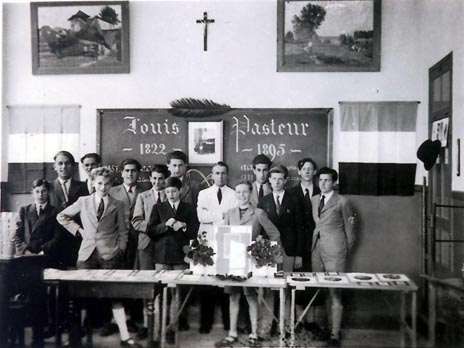
|
|
1942-1943 Classe de troisieme
Premier rang, de gauche a droite:
Jean-Loup de Menthon (France), inconnu, Ehret (France), Abbe Jacques Ceppi (Suisse), Louis-Andre de Pfyffer (Suisse),
inconnu, inconnu
Deuxieme rang, de gauche a droite:
inconnu, Dominique de Leusse (France), Claude Rieser (Suisse), P. Lodoyer (France), A. Brun (France), inconnu,
J. Godefroy (France), Rene Geiger (Suisse), Sentenac (France)
Troisieme rang, de gauche a droite :
Francois de Boccard (Suisse), Jean Murat (France), Thiebaut (France), Yves Cara (France), un inconnu
Les eleves suivants sont photographies, je n'ai pas pu les placer sur cette photo queils ont signee :
R. Boucher, Bouvier, Bertolus, Henri Rozier, B. Levylier, J.-L. Paulve
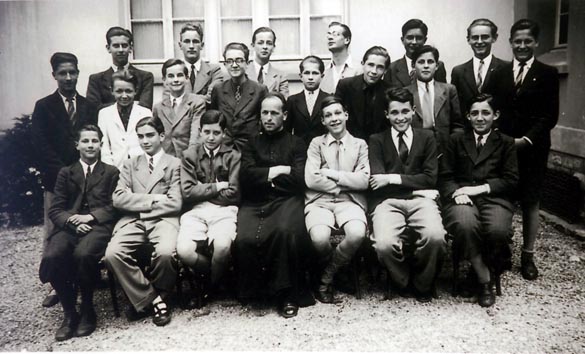
|
|
1942-1943 Classe de seconde
Premier rang, de gauche a droite:
Raymond Monnier (France), Jean-Baptiste de Weck (Suisse), Regis Boyer (France), Jean Merens (France), Michel Gouin (France),
Jean Gautier (France)
Deuxieme rang, de gauche a droite:
Etienne Burrus (France et Suisse), Dimitri Stancioff (Bulgarie), Gerard Gouin (France), Paul Berryer (France), M.Wantz (Suisse),
Faroh Meykadeh (Iran), R. Dolbeau (France), Jean-Pierre Allegre (France), Pierre Oechslin (France et Suisse),
Pierre Rudloff (France), Christian de Caritat (Belgique), Lionel Dupont (France)
Our teacher was "l'Abbe Verrier" who was also the "Prefet de la Sapiniere". All of us called him "Le Sioux", because of his very aquiline nose and his red skin. He was very respected by everybody.
At night, we heard his rather heavy and regular steps during the lecture of his breviary. He walked in la Sapiniere's corridors, in the second and third floors leading to our rooms, before we slept,
in order to avoid any inconvenience !!!
According to the legend, some of the very ancient have escaped at night for visiting some Fribourgeoise of little virtue. This exploit was called "faire le mur". But I am not sure that it is history,
probably rather fantasy of some imaginative machos.One of them was Lally de Menthon.

|
|
1944-45 Classe de philosophie
de gauche a droite:
Etienne Burrus (France et Suisse), Serge Coudon (France), Alain Savignat (France), Abbe Louis Meyer (France),
Jean-Marie Fallot (France), Etienne Carrard (seminariste, Suisse)
My class of philosophy with Abbe Meyer. We are nearly adults. We enjoyed the year which coincided with le liberation of France and the start of a new Europe
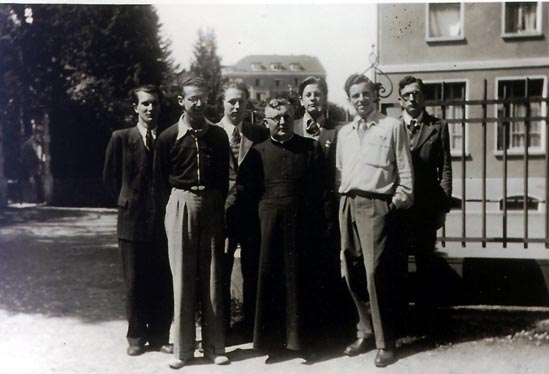
|
|
Click on link to RETURN To TOP Of Page & Local MENU
Villa St-Jean 1940-1945: L'album de photos de Guy Allegre
Guy Allegre was kind enough to send my some digital images that were important to him and that he remembers from his time (1940s) at Villa St.-Jean Collège Français.
It seems that some of the first images were from an earlier web site that François Ronsin was involved in (translating the English Wikepedia Page),
with some of the text written by Jean-Baptiste de Weck (actually see L'album de photos de Jean-Baptiste de Weck in the paragraph above to see original text and photos) . So thanks also goes out to both François and Jean-Baptiste.
Click on link to RETURN To TOP Of Page & Local MENU
Villa St-Jean 1948 - 1956: L'album de photos de François Ronsin
Printemps (Spring) 1951; Villa St. Jean, Fribourg, Suisse
Bottom row left to right with hands on ground:
Philippe Delambre, Jacques Convert.
2nd row:
Jean claude de Plinval, François Ronsin ,
3rd row: (on far right) Alain Anguenot,
4th Row :
Jean Michel Beigbeder, Bernard Humbert and Guy Burrus (with hands on head of Ronsin)
5th / Back row : Bernard Dubost, Jean Luc Monnier

|
|
Jacques Ceppi spent almost all his life at Villa St Jean as a Student then with his brother and later as a Priest and Teacher.
Every one who was at the college between 1925 and 1955 knew him.
He was in charge of sexual education.
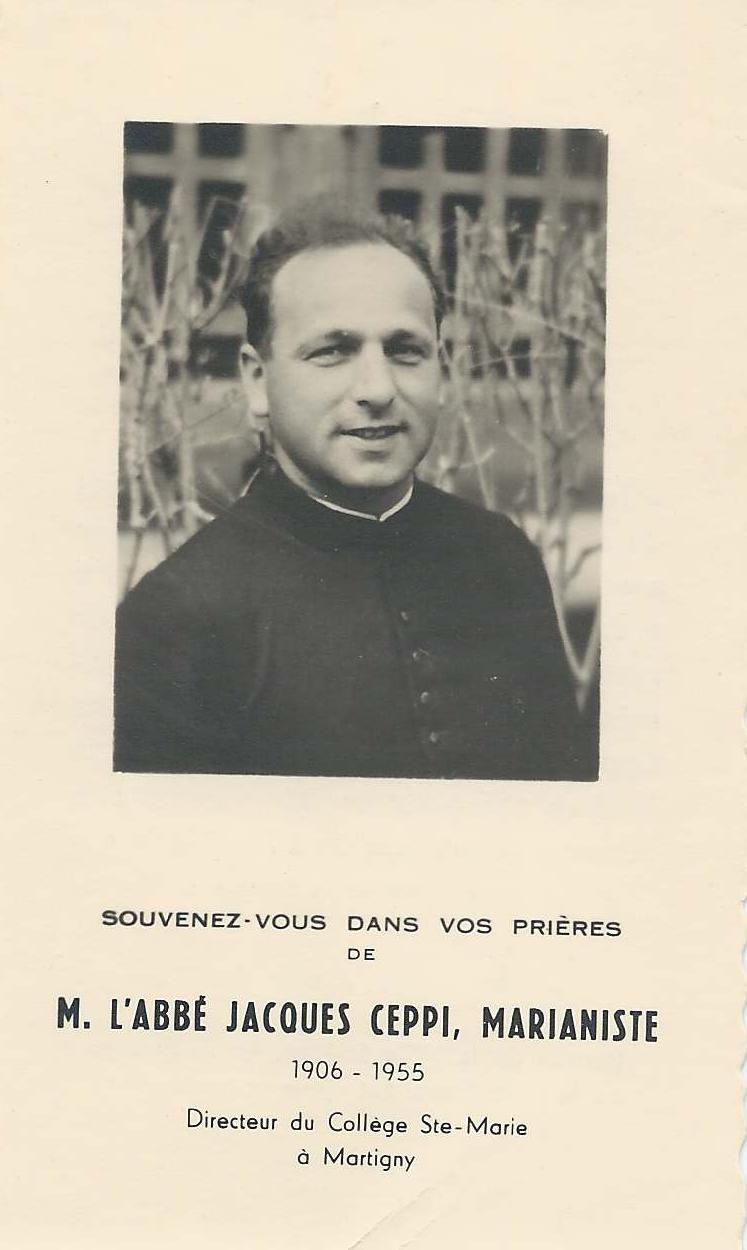
|
|

|
Student Seating Layout Arrangement for Classe de troisieme 1952-1953 Villa St Jean - with Student Signatures
(See also other PHOTO of this Class on the same day in the section by Francois de Buzon )
We were 34. The 4 PHOTOS which follow taken at various angles show the students and their signatures.
The right row is only made of 5 double desks in order to leave enough space for the teacher's desk which was on a wooden platform about 40 cm above
the floor.
The middle row had 6 double desks. The room was too small to put more.
The left row had only 5 double desks to leave enough space to allow the room door to open.
Two single desks had been added in the very left end for Philippe Douillet and Andre Trigallez.
The day that the PHOTOS were taken, Philippe Douillet was absent.

|
|

|
Classe de seconde 1953 - 1954 de Professor M. Camille Anselm
(See also other PHOTO of this Class on the same day in the section by Francois de Buzon - THIS photo shows the leftside of the class)
On the left there is a row of one seat desks.
The first boy is Bernard Wetterwald, behind him Michel Lauble, behind him Bernard Durr.
The row starting on the middle right :
1st desk at left Jean de Vibraye and Marc Freund on the right;
2nd desk Francois Delambre and Francois Bouvot,
3rd desk Jean Michel Heintz and Michel Van Tieghem,
4th desk Jean Paul Genre and Jean Claude Augrain,
last desk Michel Inoue and Kaoru Hagiwara.
For the other rows of desks on the far right of photo , refer to the Francois de Buzon photo of same class.
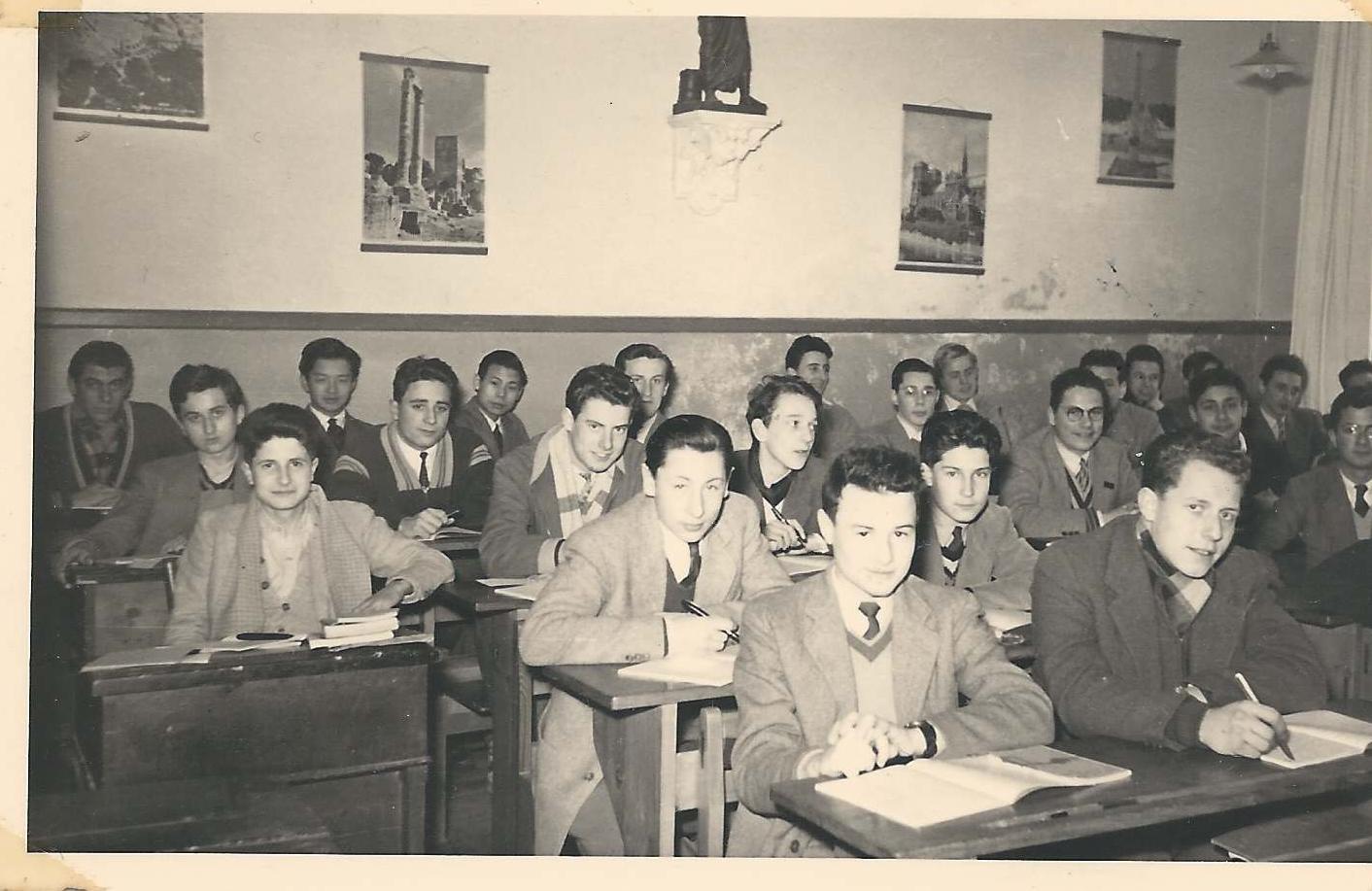
|
Pentecost (Whitsunday) 1954; Villa St. Jean, Fribourg, Suisse
In the picture those who are sitting between the table and the outside wall, from right to left :
Half of Bernard Humbert, Michel Potel is half hidden behind Jean Claude Augrain, Francois Ronsin (me), Michel Laublé is next to me half hidden by
Bernard Durr, then Dominique Donnet,and Charles Dufour.
Those who are nearest tovthe photographer include:
Bernard Durr is right in the middle of the picture (This guy was an outstanding basket player). On his left, you see Henri Marchal, then Ignacio Franco
(a South American from Columbia) shows only the back of his head and Philippe Delambre.
On the very left of the picture, Bernard WetterWald is sitting at the next table.

|
|
Photo B: Pentecost (Whitsunday) 1954; Villa St. Jean, Fribourg, Suisse
Those who are sitting back to the Wall from right to left are:
Marc Freund, Rene de Miscault, Claude Lorrain, Jean Paul Genre, Regis de Gonneville.
On the other side right to left; Francois Bouvot, Jean Francois Klein, Jean Paul Krug, Michel Inoue, Firouz Afrouz.

|
|
The IMAGES of DOCUMENTS commemorate the Ordination and First Solemn Mass of Father Charles Neumann.
He was a Marianist seminarist next to the college and excellent at BaseBall especially as a pitcher. Besides, he was our english teacher in 1952 and 1953.
In 1953 or 54, he went back to SAN ANTONIO Texas and spent a good part of his religious life over there.
I consider him as one of the best teachers I ever had.
( Editor's Note : Father Neumann would come back to the Villa in the 1963-1965 time period. For more on Father Neumann's life
see his Obituary by double clicking this link)
|
|
M. l'abbe Meyer, he was the long time Philosophie teacher until July 1950 or 51
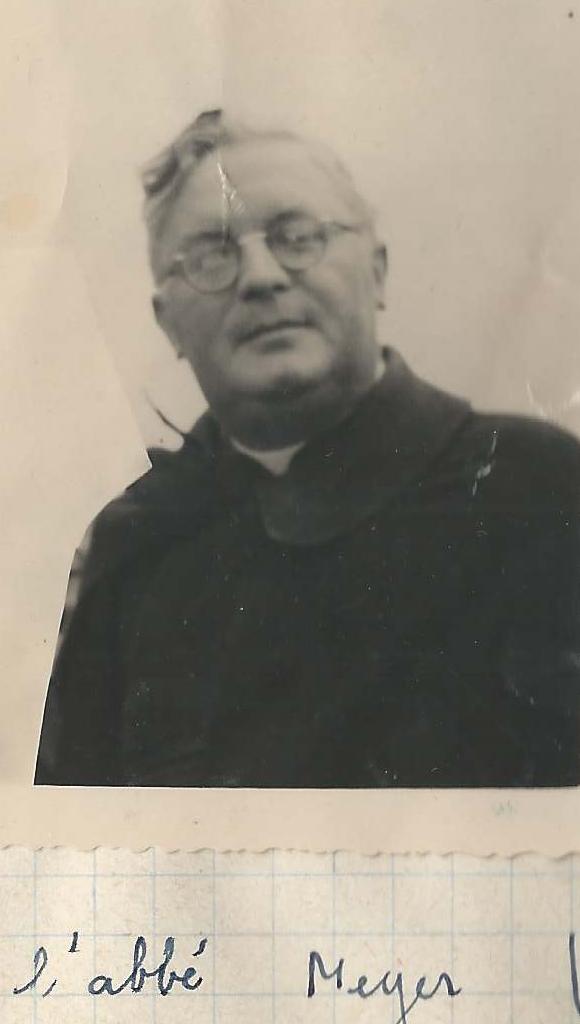
|
|
M. l'abbe Charles Newman
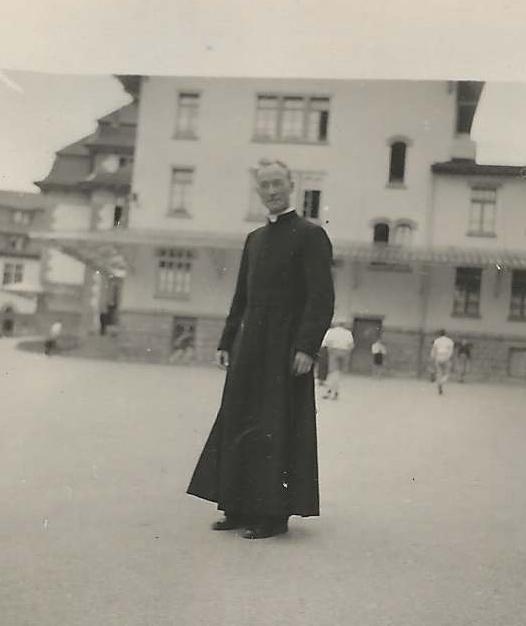
|
|
Frere Jerome Kupferle (nickname Bonne Pomme) Prefet des ormes et prof de Math a partir d'octobre 1950
et pendant au moins 5 ans.
A sa droite (avec documents), c'est l'abbe SORLIN prof de Francais, latin et Grec en 3 eme annee 51/52 et de seconde l'annee suivante.
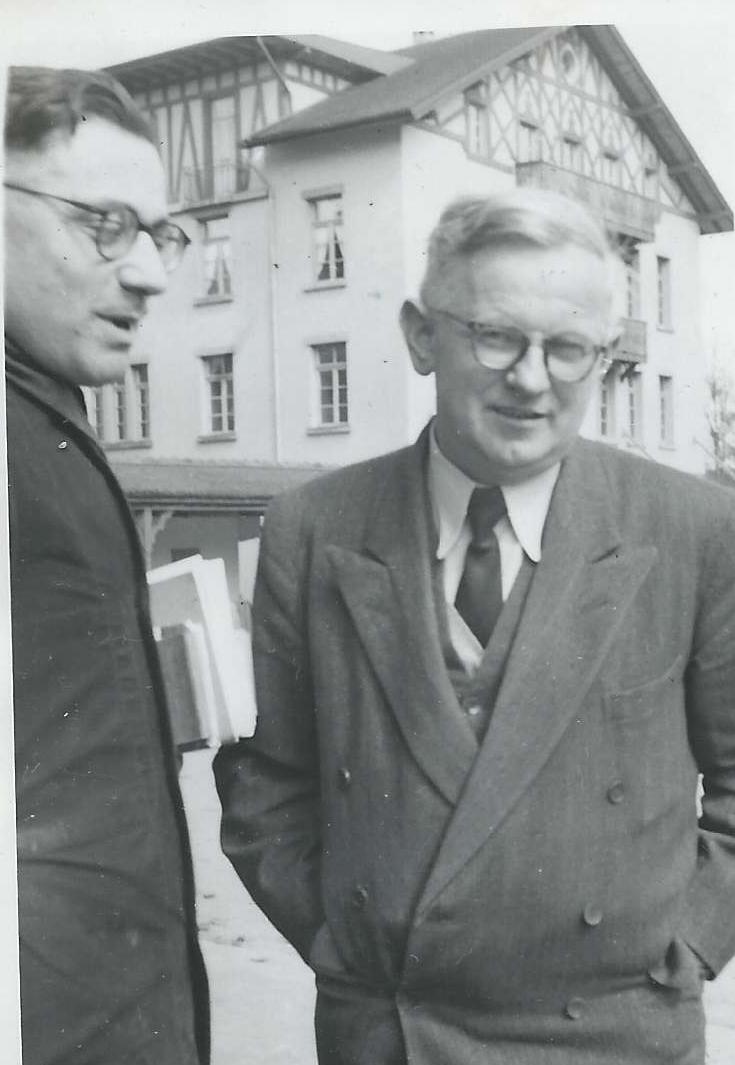
|
|
|
Click on link to RETURN To TOP Of Page & Local MENU
Villa St-Jean 1951-1953: L'album de photos de Gerard d'Orval
d'Orval for the cinquantenaire
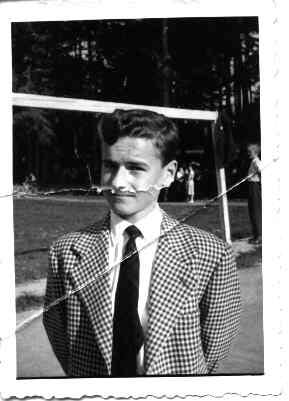
|
|
From left to right:
1) First, with the little "beret", is Mr FRITSCH. He always wore his "beret". He used to be the Teacher of Sciences "Physique et Chimie" but stopped teaching around 1952. He retired and disappeared from the
Villa the year after. He had spent all his teaching life at the Villa and was the living memory of the college. He was the one who took the radiographic picture
of the hand of Antoine de Saint-Exupéry in 1917.
At that time, he was about 37 years younger than in the picture. Being born in Alsace betwen 1870 and 1918 while Alsace was German, he could not have
come back into France after June 1940 during the German occupation
without being considered as a German deserter.
2) Next to him, is Jerome KUPFERLE (Nickname Bonne Pomme). He was Math teacher in "classes de 3eme et 4eme and Prefet des Ormes.
3) The third is l'abbe SORLIN, French, Latin, and Greek teacher classe de 3eme year 1951-52 and Classe de 2eme the year after.
4) Then l'abbe BRELOT, was French, Latin, Greek teacher classe de 4eme year 1951-52 and may be after.
5) At last, but not least. le pere Jean Marie de MISCAULT, Director of the college from October 1951. The word "Dirlo" is normal french slang for Directeur, it can be applied for any Directeur de college.
But, as I told you before, The Villa Director was "LE TRONC".
Photo Person Identification & Commentary Courtesy of: François Ronsin

|
|
Football
Behind from left to right: Christian Motte, Jacques Menoud, Dominique Donnet, Philippe Gerst, Charles Dufour
Front row : Khun Nge Sao Du, Gerard d'Orval, Michel Kussmaul, Jacques Bozon
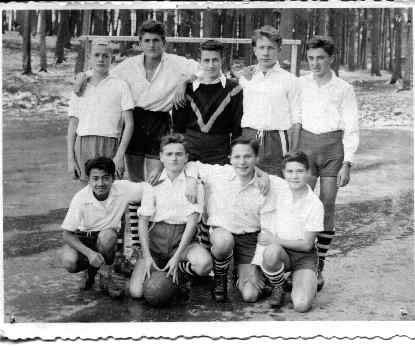
|
|
Refectoire
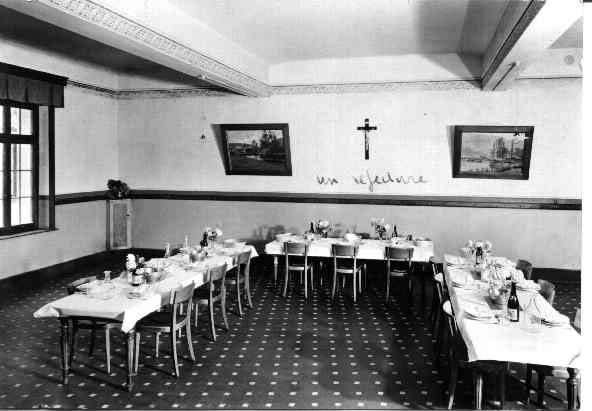
|
|
Salle d'etude seconde
The study room of classe de seconde is in la Sapiniere, you can see part of the roof of the still remaining covered playground. (Pavillion)
seconde, premiere et terminale (philosophie-mathematiques) : la Sapiniere
quatrieme, troisieme : les Ormes
sixieme, cinquieme : Gallia

|
|
Vue aerienne, august 1951
Regard the baseball diamond near the Sapiniere tennis courts.

|
|
Gerard d'Orval in Lac Noir

|
|
Francois Delambre, Gerard d'Orval and Francois Bouvot relaxing

|
|
ACF de football. from october 1952 to june 1953 no mistake we were at the Villa at that time!

|
|
|
Click on link to RETURN To TOP Of Page & Local MENU
Villa St-Jean 1952-1954: L'album de photos de Arthur de la Grandière
Villa St.-Jean Sapinière. Classe de Première 1952-1953
See PHOTO at right for student identification

|
|
Villa St.-Jean Sapinière. Classe de Première 1952-1953
Front Row Nos. 1 to 5: Bertrand de Sinéty, Alban Damour, Yves Burrus, Hubert de Miscault, et Pierre Marty
Middle Row Nos. 6 to 14: 6, ?Regis de Gonneville?, Pierre Lafond, 9, Jean Elmiger, Luitwin de Boch, 12, Arthur de La Grandiere, 14
Back Row Nos.15 to 18: 15, André Bonino, l'abbe Laurent DUFFNER , Claude Bertrand
15, 14, 12, 9, and 6 are Ivan de Longevialle, Pierre Suchail, Vincent Couturier, Jean-Pierre Mathorel, Alain Lefebvre but I am not sure who is who.
It may be interesting to note that Luitwin de Boch, Yves Burrus, Alban Damour, Arthur de La Grandiere were present during the year 48-49 in the classe de cinquieme all together with
Juan Carlos de Bourbon, the Prince of Asturies, future King of Spain.
Photo Student Identification & Commentary Courtesy of: Francois Ronsin

|
|
May 20, 1952 VSJ Soccor Team Photo : Stade 2 against Belfort. Final score Belfort 3, VSJ 2
Back Row: Arthur de La Grandière, Bernard Humbert, Iweins d'Eeckhoutte, Philippe Mottte, Bernard Dubost
Front Row: Sao Du, Bruno Carrier, Bernard Durr, Jean-Luc Foreau, Jacques Bozon, Henri Ruillier

|
|
Villa St Jean Soccer team 1952-1953:
Back Row left to right: Brother Wilfred Moran (president), Bernard Dubost , Pierre Lafond, Luc Foreau, Luitwin De Boch, B.Lemonier, Arthur de La Grandière, B. Salmon (secretary)
Bottom Row: Dollfus, Humbert, André Bonino, ? , Henri Ruillier

|
|
Retraite de Communion solennelle.
front row: Alban Damour, ?, Claude Ziere, Bernard Dubost, ? , Jean-Marie Auberger
second row: Jean Michel Beigbeder, Jacques Convert , Guy Burrus, Pitance, Henri Ruiller
third row: ?, ? , Bruno de Segogne, Arthur de La Grandiere, ? ,
top row: father x, father y

|
|
Voici
la liste des eleves qui on fait, le 10 mai, leur Profession de foi (f),
ont reeu la Confirmation (c) ou ont renouvele (r) :
Jean-Pierre Abaza (cf)
|
Bruno Dufour (cf) |
Nicolas Matossian (c) |
|
Philippe Baroux (cf) |
Jean-Pierre Eschmann (c) |
Chales Mayer (r) |
|
Patrice Belvallette (cr) |
Alain Faivre (cr) |
Gerard de Montaigu (r) |
|
Rodolphe Bogner (cr) |
Denis Humbert (cf) |
Jacques Orsel (f) |
|
Alain Brouillet (cr) |
Daniel Humbert (cf) |
Jean-Pierre Schwartz (cf) |
|
Olivier Burrus (cf) |
Jean-Jacques Humbert (cf) |
Fr.-P Thuel-Chassaigne (r) |
|
Georges Charbonnier (r) |
Baudoin de la Grandville
(f) |
Francois Ullmann du Nord (cf) |
|
Jean-Paul Damour (cf) |
Dominique de Lourmel (r) |
Claudie Desse (c) |
|
M.-Francoise Brouillet (c) |
|
Denis Burrus (Premiere
Communion) |
|
Ice hockey on the Sarine, circa 1952

|
|
Sking at Chateau d'Oex, circa 1952
Luitwin de Boch and Arthur de La Grandière

|
|
Priests from the séminaire Chaminade
At the far right is a Canadian, then Father Neumann, who went on to be the head of the Catholic University in San Antonio, Texas

|
|
VSJ Skiing Photo at Chateau d'Oex, circa 1951
Pierre Marty, Bruno Carrier, Arthur de La Grandière, Luitwin von Boch, Bernard Dubost
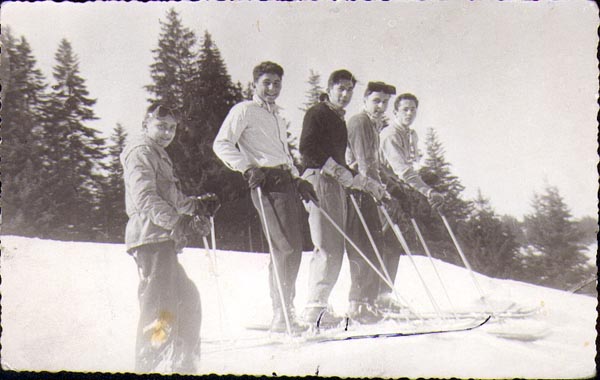
|
|
Click on link to RETURN To TOP Of Page & Local MENU
Villa St-Jean 1953-1954: L'album de photos de Francois de Buzon
classe de 3ème year 1952-53
Front Row: Alain Delepierre and Jean François Gaulis
2nd Row: François de Buzon and Bruno de Segogne
3rd Row: Charles Dufour and Jean Louis Dewatre
4th Row: Christian Motte and Jean Pierre Boisivon
5th / back row: Jean Faucher (Canadian) et Jost Elmiger

|
|
Classe de seconde 1953 - 1954 Classe de Professor M. Camille Anselm
(See Francois Ronsin's section below for another PHOTO of this class taken on the same day)
For the row of desks on the right,
1st desk Jacques Bozon is alone,
2nd Desk Bruno Urbain and François Ronsin
3rd desk Philippe Francin and Guy Brémard,
4th desk Jean Pierre Boisivon and Guy Burrus,
5th desk Jean Rémy and René de Miscault.
For the row of desks in the Middle of the Photo
1st desk Jean Francois Gaulis (with pen),
2nd Desk François de Buzon,
3rd desk Michel Kussmaul and Firouz Afrouz,
4th desk Philippe Douillet and Jost Elmiger,
5th desk Gérard d'Orval and Christian Motte.
For the row of desks on the Left of the Photo (more difficult)
1st desk Jean Michel Heinz and Michel Van Tieghem
2nd Desk Michel Laublé, Jean Paul Genre, Augrain,
3rd desk Kaoru Hagiwara, Michel Inoué, Bernard Durr, teacher M. Camille Anselme
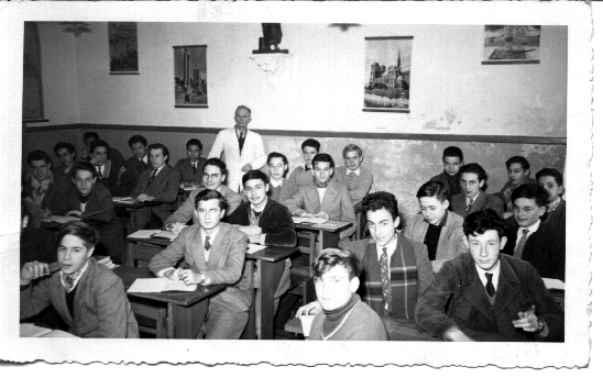
|
|
We are at la Sapiniere and permitted to smoke on very special occasions like attending a concert at the Aula of the University.
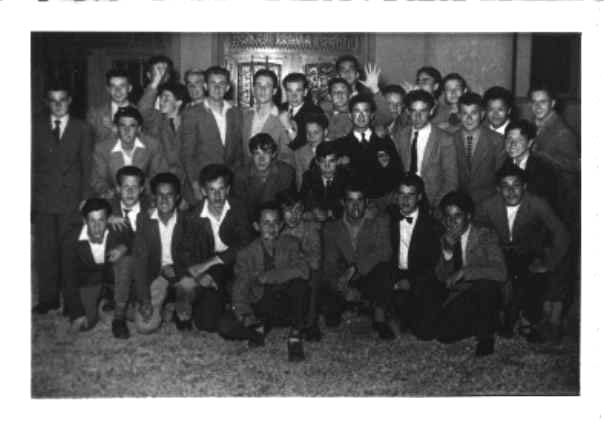
|
|
Francois de Buzon Fencing

|
|
Francois de Buzon Playing Baseball
Somehow the New York Giants won the 1954 World Series without Francois.

|
|
Francois de Buzon Playing Tennis
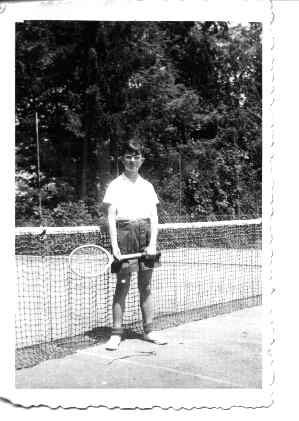
|
|
Francois de Buzon
I sure love Latin : alumnus, alumnae, alumna, alumni, not bad !
The opinion of l'abbe Brelot was slightly different he thought that my future was to break stones in the desert, not with but under the control of the foreign legion.

|
|
Menu Pentecete 1953, le 24 mai
This is the 50th anniversary dinner menu.
The dinner was held at the now defunct Hotel de Fribourg
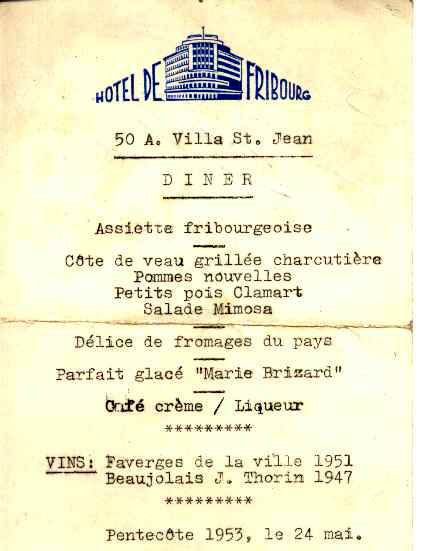
|
|
A photo of Guillaume Joseph Chaminade from Francois's missal
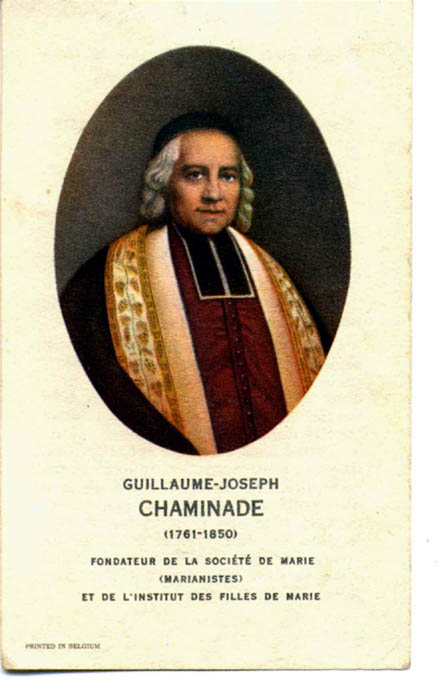
|
|
Guillaume Joseph Chaminade Prayer

|
|
Click on link to RETURN To TOP Of Page & Local MENU
Villa St-Jean 1952-1957 L'album de photos de Francois Ullmann
These two remarkable photos (including one on the right) of St. Exupery were published on the tenth anniversary of his death (1944-1954) in the Villa St-Jean Souvenirs de l'Ann�e .
"I like it here," the Saint-Jean student informed his mother in a statement that could serve as an epigraph to his glory days. "It's a little severe, but everyone is imbued with a great sense of justice."
(pg. 57 of the Stacy Schiff biography)
Click on hyperlink to Read about St. Exupery at Villa St-Jean

|
|
See caption at the left
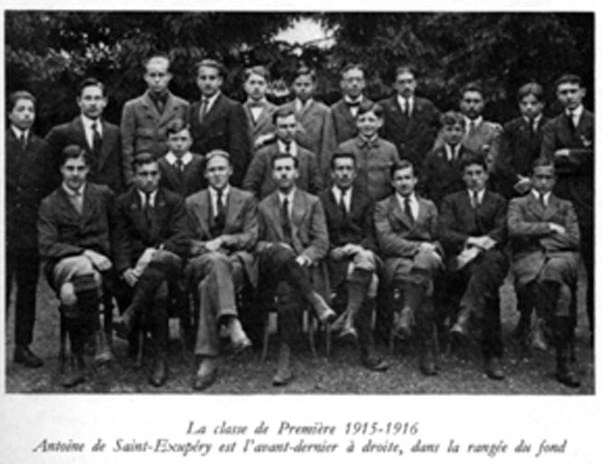
|
|
This end-of-year shot was taken in Spring 1956
Last row center is Olivier de la Grandville; to the right, Michel de Millo; I'm second row to the right, with both shoulders visible.
The teacher's nickname was Cyclopes, he had one eye half-closed due to some accident, his real name, Noblot. He was also sous-directeure and in charge of Les Ormes, fourth and third French grades, corresponding to age 12-14).
Gallia was 6th and 5th grades, age 10-12; and aLa Sapinieree, 2nd, 1st grades, and Terminale Philosophie-Mathematiques (1st grade and Terminale corresponds to junior College)

|
|
In those days we had a habit of getting everyone to sign the photos.

|
|
La classe de M. Gremaud (5e, 1953-1954) :
Carlo Fioroli et Jean-Pierre Dorget (first row), Xavier de Foras et Francois Ullmann (second row),
Dominique de Lourmel et Alain Brouillet (third row).
Le doigt leve: Jean-Fred Odicino et Michel de Millo; Jean-Luc Leconte en contrebas du castor (beaver).
Quels sont les autres?

|
|
Francois Ullmann rame (rows) sur un lac suisse.
Lequel? (Lac Noir?)
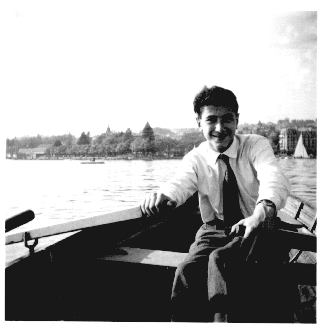
|
|
|
|
The classroom photo is from 1953 or 1954. I'm in the first row, second from left. Olivier de la Grandville is third from left.
Most students were French, then Swiss. They were also from every possible country, 229 in 54-55, (175 French, 27 Swiss) 252 in 55-56 (196 French, 30 Swiss), 258 in 59-60 (176 French, 42 Swiss).
I still wonder why the "French Villa" closed!
Saint-Jean was strictly a boys' institution. but, in last year of French High School : philosophie-mathematiques (junior College level in the US), there were a few girls, from the outside, and just for class-time.
Number of girls: None in 1953-1954, 2 in 1954-1955, none in 1955-1956, 4 in 1957-1958, ? in 1958-1959 (I seem to have lost that one) and 5 in 1959-1960.
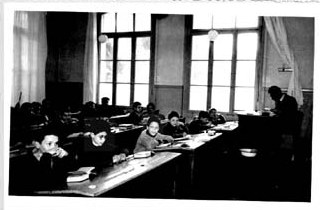
|
|
This photo is contained in a 1950's Villa St-Jean Souvenirs de l'Annee.
M. l'abbe Kieffer
Directeur fondateur de la Villa St-Jean
directeur de 1903-1918

|
|
Click on link to RETURN To TOP Of Page & Local MENU
Villa St-Jean 1954-1958 L'album de photos de Roland Bonnefous
On peut voir, en partant du fond et en remontant:
Ned FIDEL (USA), ver la gauche Tilli MAURO (I), Nicolas WALLAERT (F), Christian CARA (F), Guido CHIALVO (Italie), Patrick de SAINT MARTIN (F),
en revenant a droite de ANDRIA (F), de REINARCH (F), DUFRAICHE (F), Jean-Louis de MISCAULT (F)
au premier plan a gauche et derriere Kim JACQUEMIN (F), Renaud BAYOT (B) tellement applique sur son devoir qu'on l'apercoit a peine, Patrick LAMY (F)
juste derriere votre serviteur en premier plan (qui donne l'impression de travailler, mais n'en fichait pas une) Roland BONNEFOUS (F).
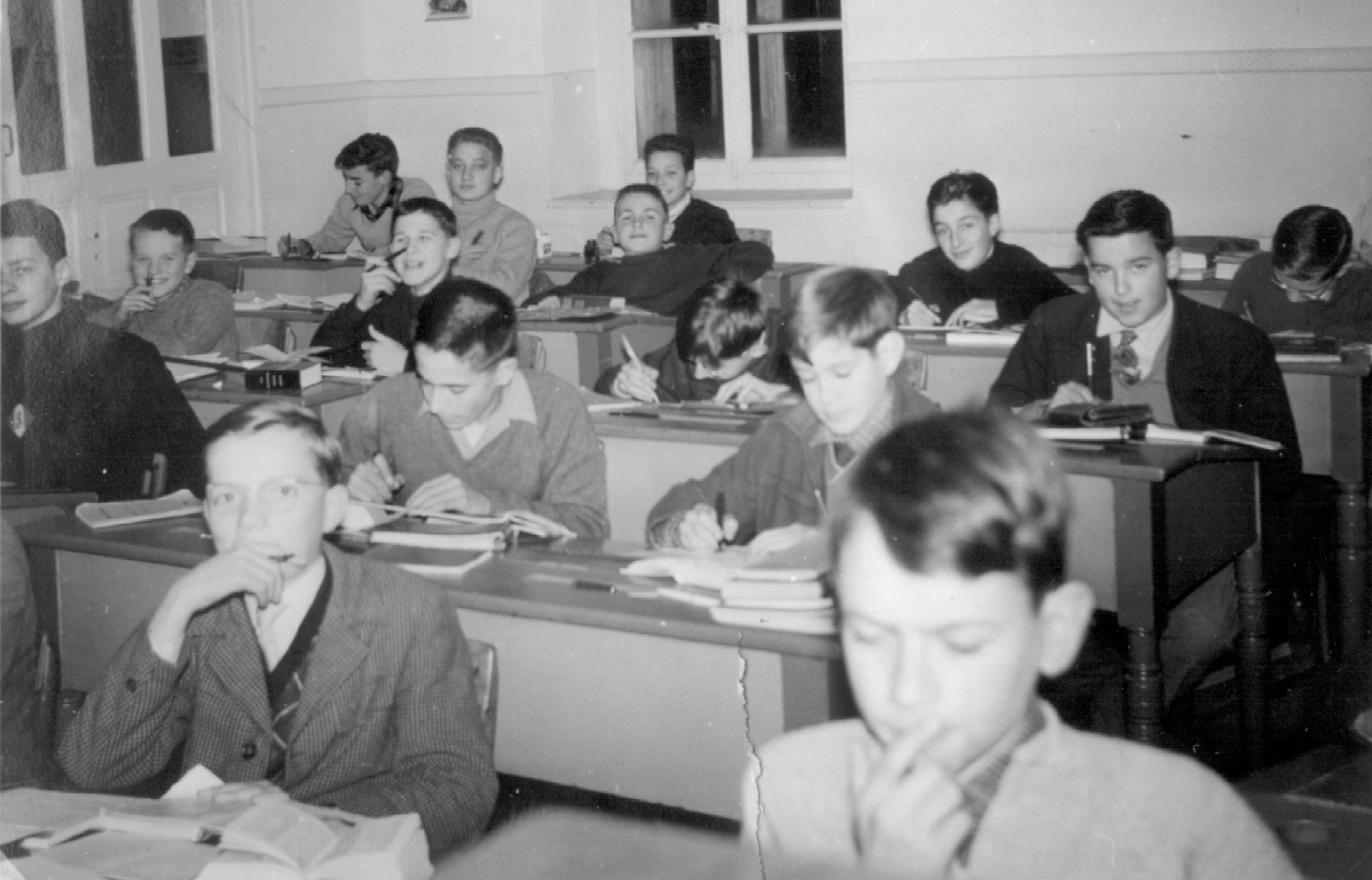
|
|
Nous voici au dortoir des Ormes (classe de 4e) avec notre surveillant que nous surnommions "Gestapo".

|
|
Voici une photo qui doit dater, je pense, de la classe de 5e.
On peut y voir, de gauche a droite, en commencant par le haut:
CARA, Xavier ELORZA, ?, Roland BONNEFOUS
Jean-Paul ALLARD, BATTISTELLA, Patrick de SAINT MARTIN.

|
|
|
Click on link to RETURN To TOP Of Page & Local MENU
Villa St-Jean 1954-1960 L'album de photos de Gerard Orsel
1957/1958 Photo de la classe de 3e
de gauche a droite:
Troisieme rang: Phillipe Embiricos, Michel Poulet, Biron, Jean-Jacques Glasson, Eric de Beru, Leclerc, Hubert de Camaret, Michel Vannod, Joel de Pougnadoresse, Monnier, Schwartz, Alain Frahinsholz, et Chiffer.
Deuxieme rang: Bernard de Reinach, Francis Tresch, Jerome Gratry, Python, Cupillard, Joly, Cherrey, de Gigord, Ernst
Premier rang: Jean-Jacques Casper, Paul Bruno, Gerard Allain, Claude Lemarechal, Girard, le pere Noblot (prefet des Ormes), Thierry Damour, Gerard Orsel, Patrice Torok et Phillipe de Verthamon
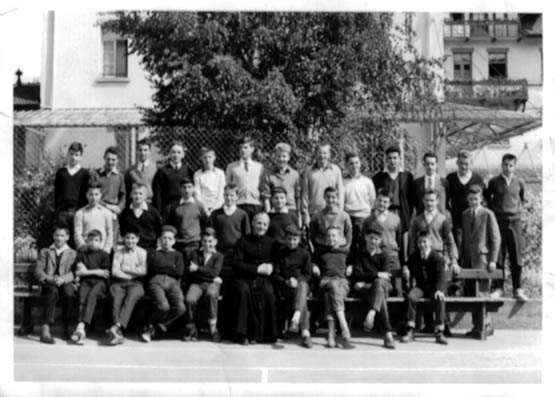
|
|
1958/1959 Photo de la classe de 2e
de gauche a droite:
Cinquieme rang: Jean-Jacques Glasson, Alain Frahinolz, Hubert de Camaret, Claude Rinck, Blancheret
Quatrieme rang: Jerome Gratry, Jean-Louis Colot, Eric de Beru, Patrick Mollet-Vieville, Francois Kuehn, Monnier
Troisieme rang: Francis Tresch, Phillipe Embiricos, Claude Schreiner, Claude Lemarechal, Gerard Orsel, Pascal Hurbain
Deuxieme rang: Claude Darlix, Michel Poulet, Bernard de Reinach, Patrice Torok et Patrick Orban
Premier rang: Jean-Jacques Cherrey, Jean-Jacques Casper, Thierry Damour, le professeur de Lettres classiques Mr. Anselme, Gerard Allain, Paul Bruno et Phillipe de Verthamon
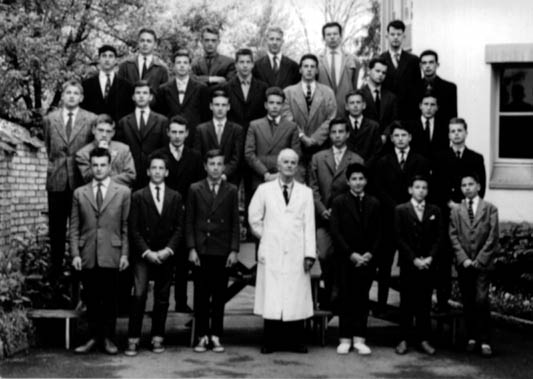
|
|
1958/1959 Photo de la classe de 2e
de gauche a droite:
Cinquieme rang: Francis Tresch, Francois Kuehn, x, x, Thierry Damour, Jerome Gratry, Hubert de Camaret
Quatrieme rang: Gerard Allain, Paul Bruno, x, Mulliez, Jean-Jacques Casper et Eric de Beru
Troisieme rang: Jean-Jacques Ricaud, Francois Desfossez, x, x, Gerard Schreiner, x, x.
Deuxieme rang: Gerard Orsel, Jean-Louis Colot, x, abd et Kader, x, x.
Premier rang: Flamant, Olivier de Saint Laon, Cavrois, le pere Bruckner (professeur de Lettres classiques), Claude Rinck, Francois-Charles Uginet, et Gerard Plancherel
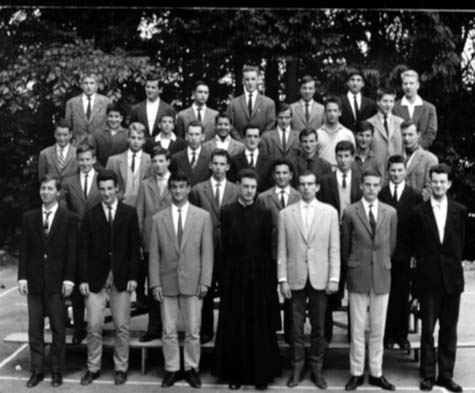
|
|
1958/1959 Photo de la classe de 2e Autographs

|
|
1960/1961 Photo Terminale (Classe de Philosophie-Mathematiques)
de gauche a droite:
Quatrieme rang: Francois-Charles Uginet, x, x, x, Claude Rinck, x
Troisieme rang: Gerard Orsel, x, x, de Carvalho, Jean-Louis Colot, x
Deuxieme rang: x, x, Olivier Burrus, x, Abd el Kader
Premier rang: Paul Bruno, x, Mr. Masse, professeur de Sciences naturelles, x, Gerard Allain, x

|
|
1959/1960 Photo de l'equipe de foot de la Sapiniere
Deuxieme rang: Olivier de Saint Laon, Thierry Damour, Febo de Andrea, Jean-Jacques Ricaud, x
Premier rang: Gerard Allain, Coquille, Gerard Orsel, Jean-Pierre Thevenet, et x
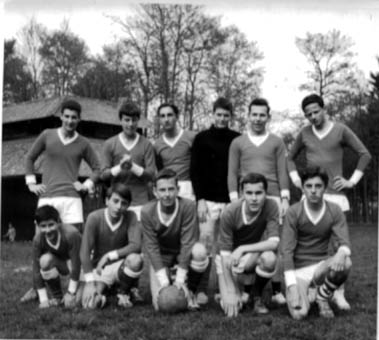
|
|
Photo du baby-foot
G�rard Orsel, Jean-Jacques Ricaud, Bernard de Reinach
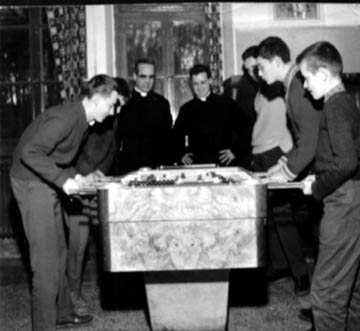
|
|
Jean-Louis Colot en plein effort
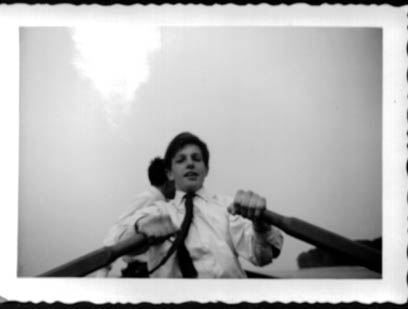
|
|
Experience de physique:
Gerard Orsel, de Carvalho et Gerard Allain

|
|
Experience de Chimie:
Gerard Allain, de Carvalho et Gerard Orsel
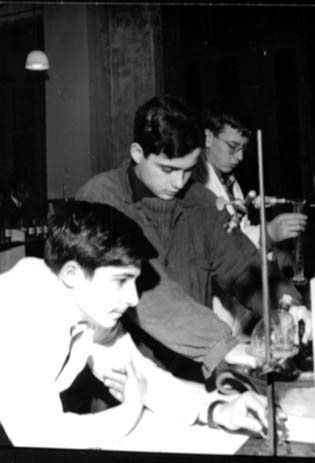
|
|
1954/1955 Photo de classe de 6e entourant Mr Schmitt, prefet de Gallia.

|
|
|
Click on link to RETURN To TOP Of Page & Local MENU
Villa St-Jean 1957-1961 L'album de photos de Francois de Reinach
Robert Jarzac
1960-1961

|
|
Francois de Reinach, Michel de Chateauvieux (assis)
1958-1959
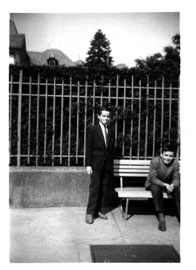
|
|
Gerard Girardet, Francois de Reinach, Alain Monnier, ? , Jean-Pierre du Rusquec, Mauro Tilli
1960-1961
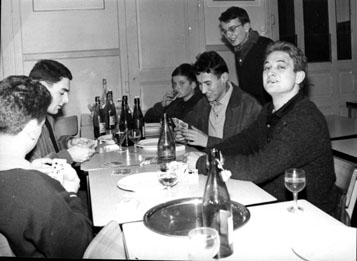
|
|
?, Calvet, Francois Kuehn, Michel Cherrey, ?, Bruno Kaufmann
1960-1961
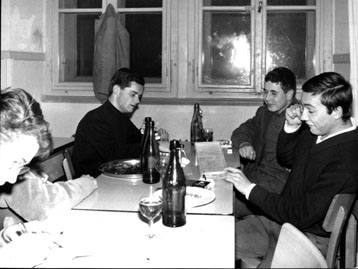
|
|
Pere Andlauer, Claude Rinck, Gerard Allain, ?, Pierre-Jan Indekeu, ?, ?, ?
1960-1961

|
|
Cours de Judo
1960-1961

|
|
Michel Perret et le prof de judo ( Mr Paillard)
1960-1961
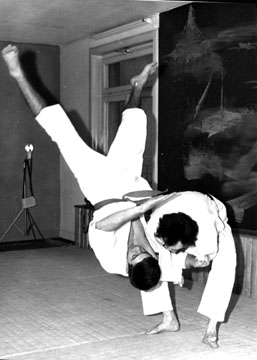
|
|
Classe de premiere ( + Mr l'Abbe Duffner)
1960-1961
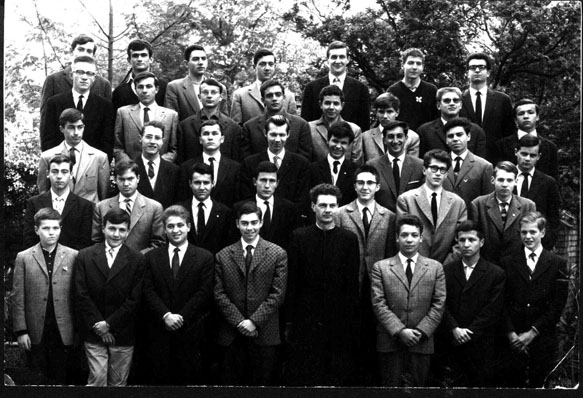
|
|
Classe de troisieme ( + Mr Terrapon)
1958-1959
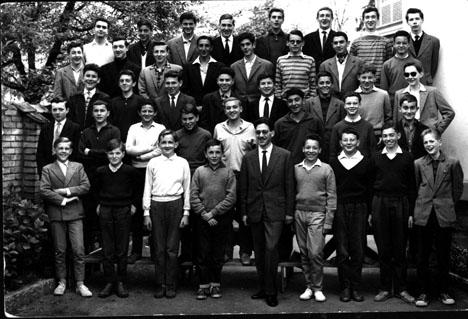
|
|
Classe de quatrieme ( + Mr Terrapon)
1957-1958

|
|
Click on link to RETURN To TOP Of Page & Local MENU
Villa St-Jean 1961-1962 : L'album de photos de Vincent Farage
La Villa St Jean 1961-1962

|
|
M. Anselm, prof. de Francais
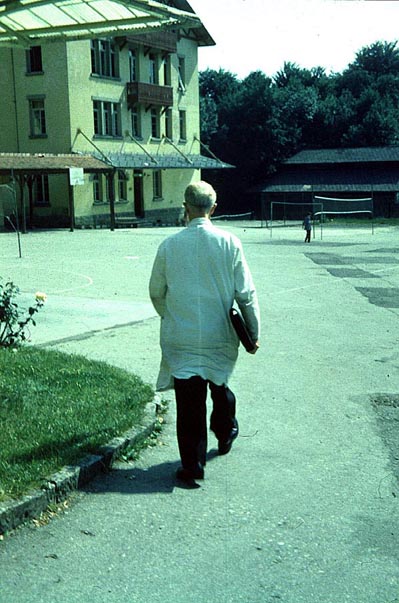
|
|
Leon de religion en classe de quatrieme
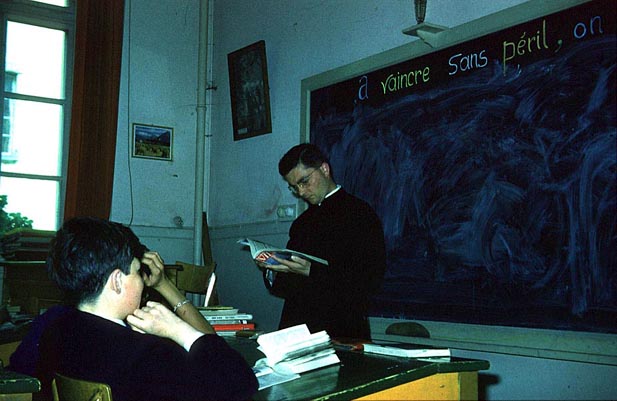
|
|
La prof d'Anglais en classe de quatrieme
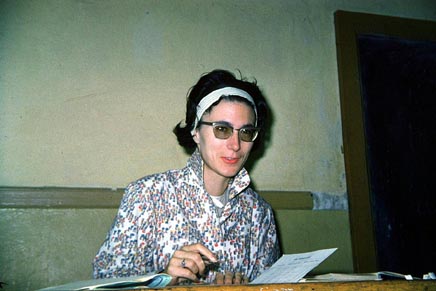
|
|
La prof d'Anglais en classe de quatrieme 2

|
|
|
|
Une boum aux Ormes
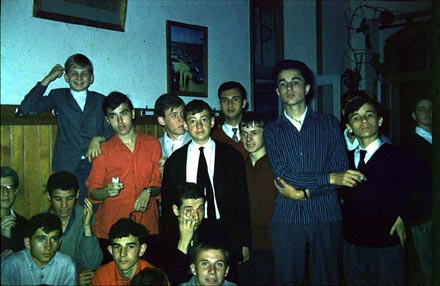
|
|
Une boum aux Ormes

|
|
Une boum aux Ormes

|
|
Une boum aux Ormes
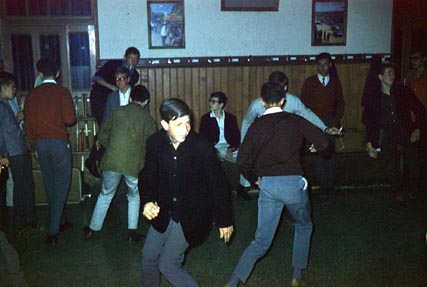
|
|
Une boum aux Ormes
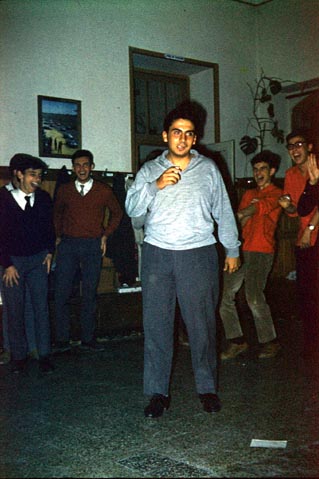
|
|
Une boum aux Ormes

|
|
"Au theatre, ce soir..."

|
|
"Au theatre, ce soir..."

|
|
Un ami, comment s'appelait-il?
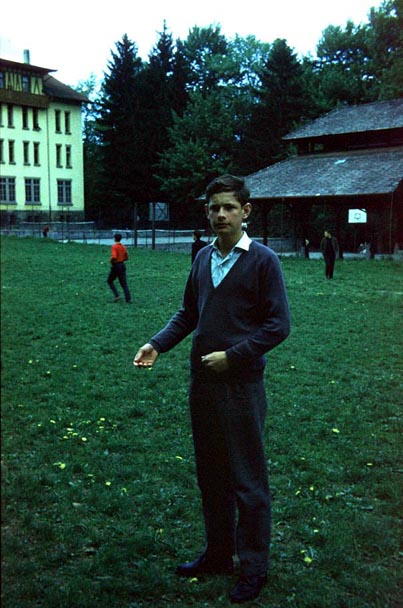
|
|
Click on link to RETURN To TOP Of Page & Local MENU
Ralf Brooks' Villa St.-Jean Collège Français & International School WEB SITE
Copyright © 2014, 2015, 2016, 2017, 2018, 2019, 2020, 2021, 2022, 2023, 2024 Ralf Brooks, All Rights Reserved















